Physical Address
304 North Cardinal St.
Dorchester Center, MA 02124
Because oral and oropharyngeal problems and disorders are common and cause a wide variety of symptoms, routine and thorough oral examinations are an essential component of a complete physical examination; this enables the practitioner to make an appropriate diagnosis without undue delay. The American Academy of Pediatric Dentistry (AAPD) recommends that children are seen for a dental exam by no later than 1 year of age.
Key elements of the oral/dental history include the following:
Timing of eruption and exfoliation of primary teeth, timing of eruption of permanent teeth, and any problems encountered
Brushing and flossing frequency and technique
Dietary habits, including frequency of bottle-feeding and breastfeeding in infancy, whether infants and toddlers are put to bed with a bottle, time of weaning, frequency of carbohydrate intake, and possible symptoms of eating disorders in adolescence
Current source of dental care, frequency of visits, establishment of a dental home
Current history of symptoms: oral pain, redness, swelling, drainage, headaches, abdominal pain, decreased appetite
Problems with bite or occlusion
History of dental problems and/or orofacial trauma as well as their treatment
Family history of dental problems or disorders
A systematic approach to the examination of a child’s dentition is essential and should include assessment of the following:
Facial symmetry and balance
Lip seal at rest position
Occlusion (bite) and tooth alignment
Integrity of enamel, presence of caries
Appearance of gingiva from both labial/buccal and lingual sides
Condition of the other oral soft tissues: tongue, palate, tonsils, mucobuccal folds, and sublingual spaces
Successful examination requires close visual inspection of the face, palpation of suspected areas of abnormality, and systematic inspection of the dentition, its supporting structures, and the oral soft tissues. In younger children, a “lap exam” may be a useful way to examine an apprehensive child ( Fig. 21.1 ). The parent lays the child in their lap, facing them, and the child’s head reclines into the examiner’s lap. It is important to have the parent hold the child’s hands throughout the examination. A lap examination is not advised if the mother is pregnant, because the child may accidentally kick the mother. If cooperation cannot be achieved despite these measures, immobilization in a papoose board may be necessary. With older children, examination of the patient in the supine or semi-recumbent position with good lighting assists visualization and may be more practical.
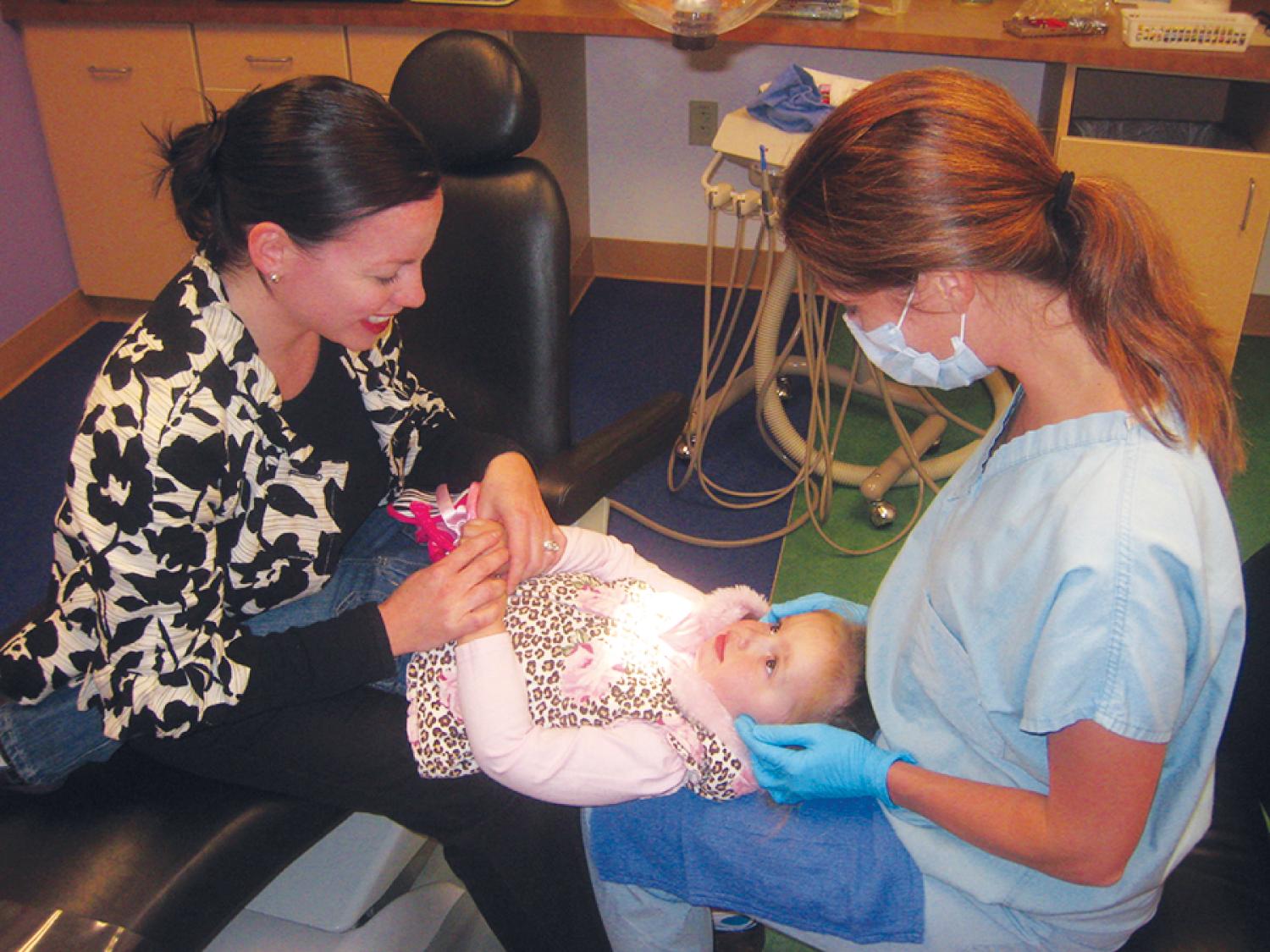
Use of a dental mirror or tongue depressor may be necessary to ensure direct visual access to all intraoral areas, especially in assessing the lingual surfaces of the anterior teeth and gingiva as well as the buccal surfaces of posterior molars. Extra effort and patience may be required to ensure that the mucobuccal folds, sublingual space, lingual surface of the anterior teeth, and anterior palate are adequately visualized.
The oral cavity, including the teeth, gingiva, and periodontal ligaments, is in a constant state of change during infancy and childhood. From the early teething stage, to eruption and exfoliation of the primary dentition, and finally to the eruption of all permanent teeth, the oral cavity provides one of the most dynamic signs of development.
To assist in the understanding of this chapter as well as the communication with consulting dentists, a review of basic terminology is helpful. Each tooth is composed of an outer protective enamel layer, an inner layer of dentin consisting of tubules, which are thought to serve a nutritional function, and a central neurovascular core termed the pulp or nerve. The roots of the teeth are anchored in the sockets of the alveolar processes of the mandible and maxilla by an encompassing periodontal membrane or ligament. The neurovascular supply to the root apex also passes through this structure. The bony processes between the teeth are referred to as the interdental septae ( Fig. 21.2 ). After eruption, the visible portions of teeth are referred to as the crowns, and the interface between them and the gingiva is termed the gingival crevice. Finally, the portions of the gingiva located between teeth are called interdental papillae.
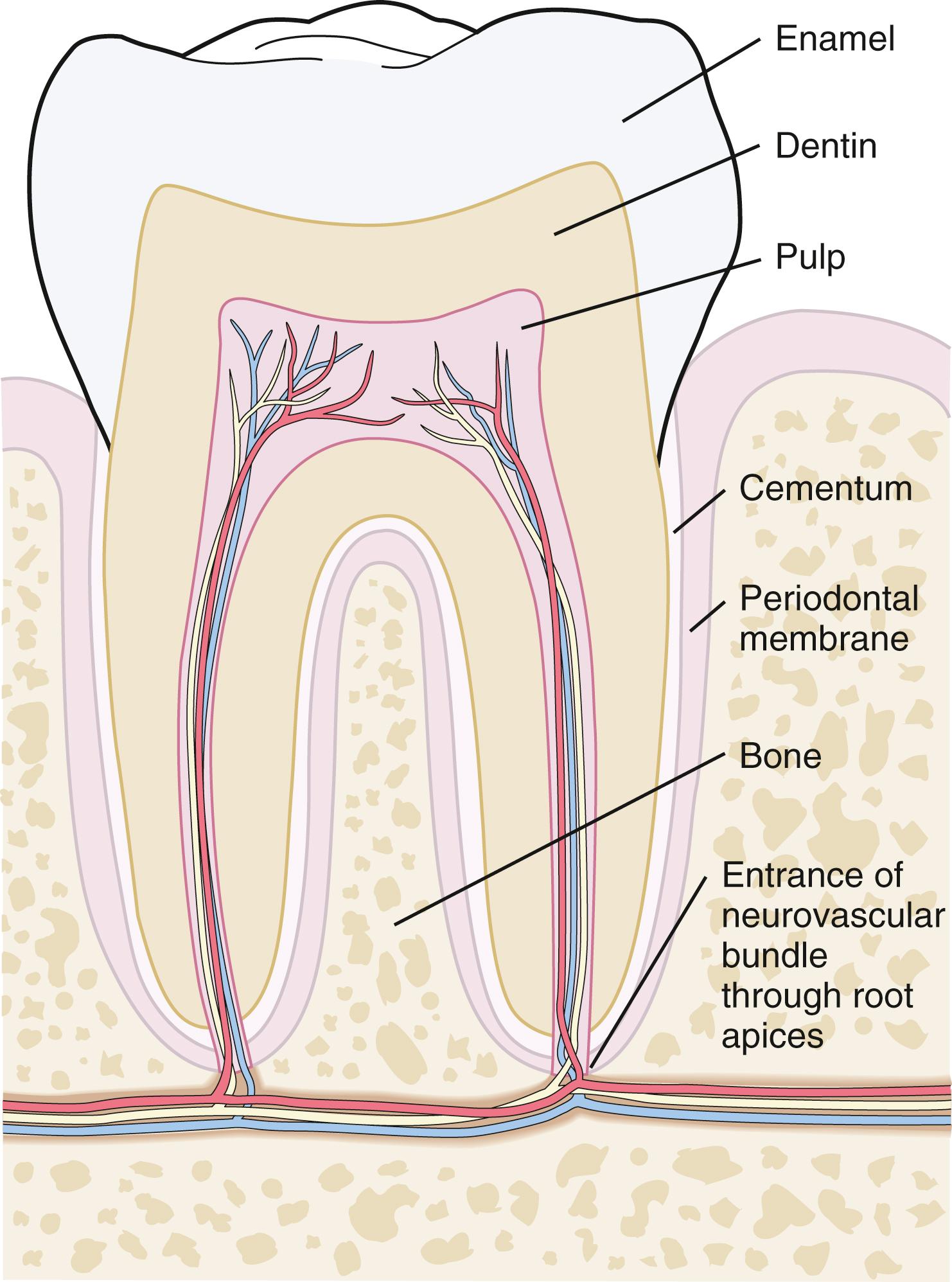
The lips of an infant reveal a prominent line of demarcation at the vermilion border. The mucosa may look wrinkled and slightly purple at birth, but within a few days it exhibits a drier appearance, with the outer layer forming crusty “sucking calluses.” This callus formation affects the central portion of the mucosa and persists for a few weeks to a few months ( Fig. 21.3 ).
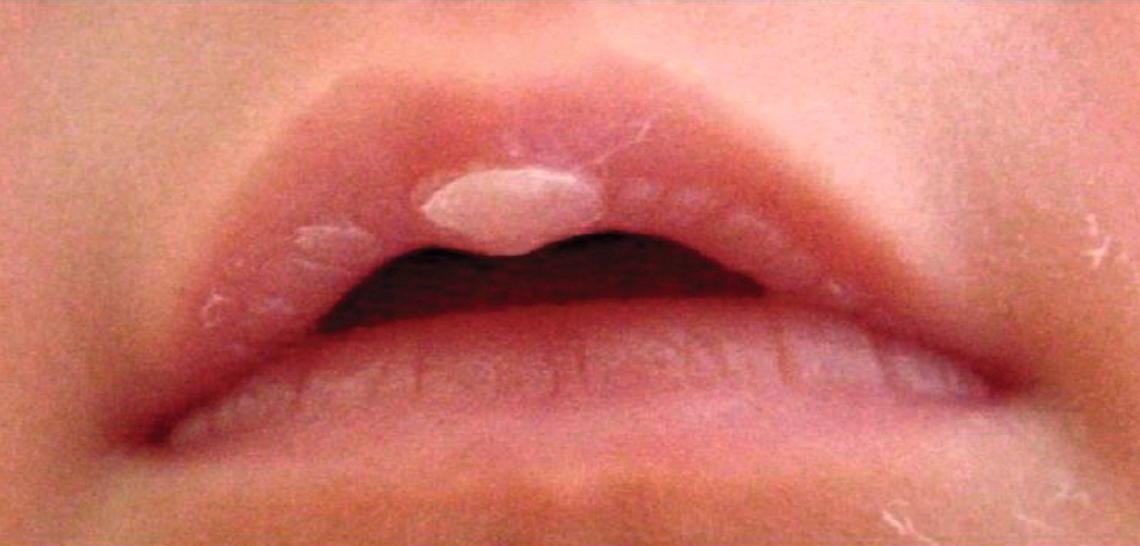
The maxillary alveolar arch is separated from the lip by a shallow sulcus. In the midline, the labial frenulum extends posteriorly across the alveolar ridge to the palatine incisive papilla. The alveolar ridge peaks anteriorly and gradually flattens as the ridge extends posteriorly, forming a pseudoalveolar groove medial to the ridge along its palatal side. This flattened appearance is seen in infants and gradually disappears with the growth of the alveolar process and the formation and calcification of posterior tooth buds. The mandibular alveolar ridges also peak anteriorly and flatten posteriorly. The mandibular labial frenulum connects the lower lip to the labial aspect of the alveolar ridge. Careful visual inspection and palpation of the ridges should confirm the presence and location of tooth buds. Anterior tooth buds are located on the labial side of the alveolar ridges, whereas posterior tooth buds are often located closer to the crests of the alveolar ridges. Palatal morphology and color are variable. The tongue and the floor of the mouth differ only slightly from those of older children.
Development of the alveolar bone is directly related to the formation and eruption of teeth, and normal patterns of dental development occur symmetrically. Eruption times and sequence are variable, but begin at approximately 6 months old, when mandibular central incisors erupt ( Fig. 21.4 ). This stage is often preceded by a period of increased salivation, local gingival irritation, and irritability. These symptoms may vary in intensity, but they respond well to oral analgesics and usually subside when the primary tooth erupts into the oral cavity. Other symptoms such as fever or diarrhea are not directly related to teething. By 3 years old, the full primary dentition is typically present and functional ( Fig. 21.5 ).
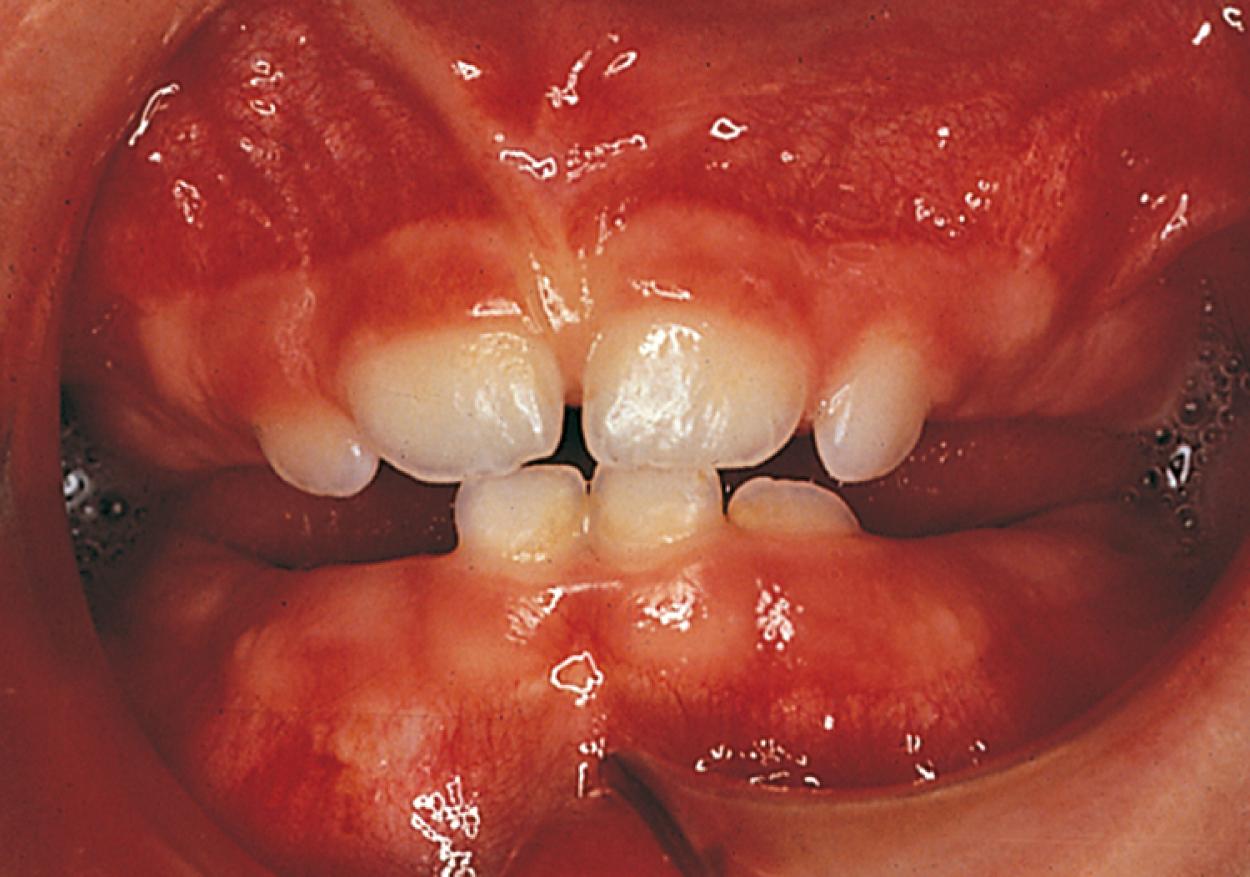
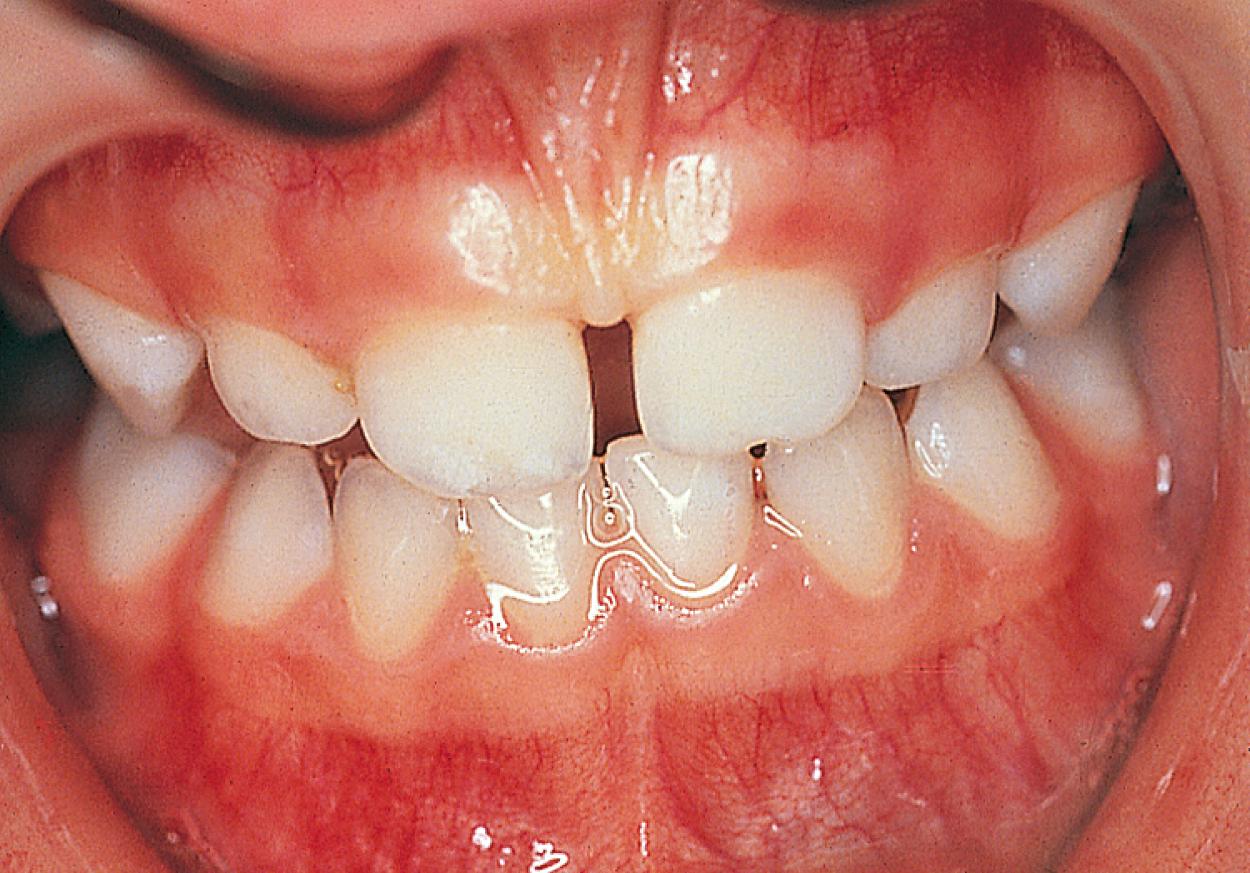
Any significant variation in the time and sequence of eruption in an otherwise normal infant may call for early dental referral. In most instances, careful observation is indicated. For example, delayed eruption of primary teeth for up to 8 months is occasionally observed and, if seen in the absence of other abnormalities, may be a normal variation. Delayed dentition can be a feature of moderate to severe cases of failure to thrive, where it is seen in association with, and is a visible reflection of, delayed bone age. More rarely, delayed eruption is associated with Down syndrome, hypothyroidism, hypopituitarism, achondroplastic dwarfism, osteopetrosis, rickets, or chondroectodermal dysplasia. A significant variation affecting a single tooth or only a few teeth should be carefully investigated as well. Extra space between teeth during this stage is normal and desirable, often indicating that more space is available for the larger permanent teeth.
During most of the primary dentition stage, the gingiva appears pink, firm, and not readily retractable. A well-defined zone of firmly attached keratinized gingiva is present, extending from the bottom of the gingival sulcus to the junction of the alveolar mucosa. Rarely, local irritation may develop into acute or subacute pericoronitis, with elevated temperature and associated lymphadenopathy (see Fig. 21.49 ). Topical and/or systemic therapy may be required for treatment; however, lancing the gingiva to relieve such symptoms is not usually indicated.
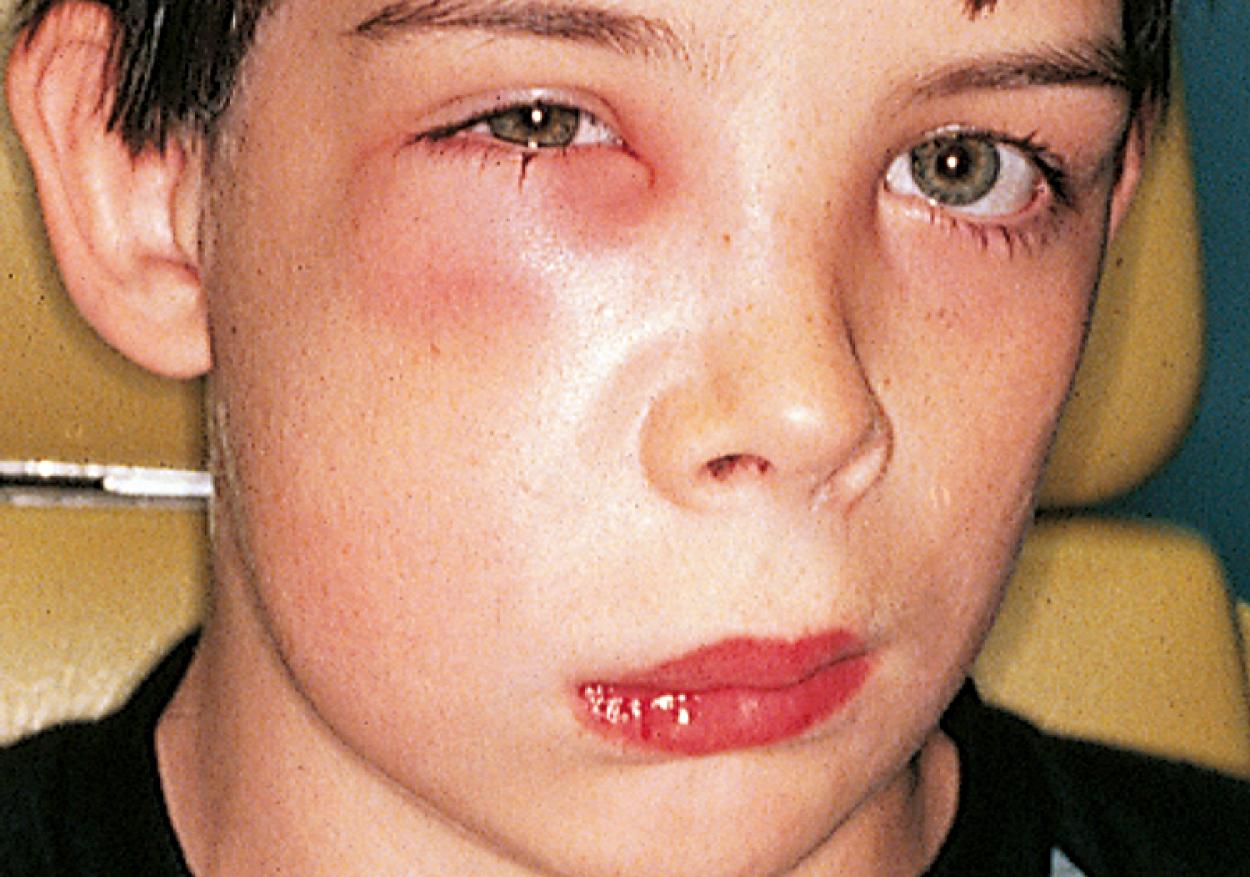
The mixed dentition stage of development begins with the eruption of the first permanent molars at about 6 years old and continues for approximately 6 years. ( Fig. 21.6 ) See Fig. 21.9 for order of eruption. The mixed dentition during this stage undergoes certain physiologic changes, including root resorption followed by exfoliation of primary teeth, eruption of their successors, and eruption of the posterior permanent teeth. During the period of root resorption of primary teeth, and for several months after the eruption of permanent teeth, the teeth are relatively loosely embedded in the alveolar bone, making them more vulnerable to displacement by trauma. Other minor complications may occur during resorption and exfoliation of primary teeth and eruption of permanent teeth; for example, gingival irritation can occur as a result of increased mobility of primary teeth, but usually disappears spontaneously when the tooth is lost or extracted. Two transient deviations of eruption pattern may occur: (1) the mandibular incisors may erupt in a lingual position behind the primary incisors (“double teeth”) ( Fig. 21.7 ), and (2) the maxillary incisors may assume a widely spaced and labially inclined position (“ugly duckling” stage). The occlusal surfaces of newly erupted permanent teeth are relatively “rough” (see Figs. 21.6 and 21.43 ), assisting plaque accumulation that increases the risk of staining, gingivitis, and formation of caries.
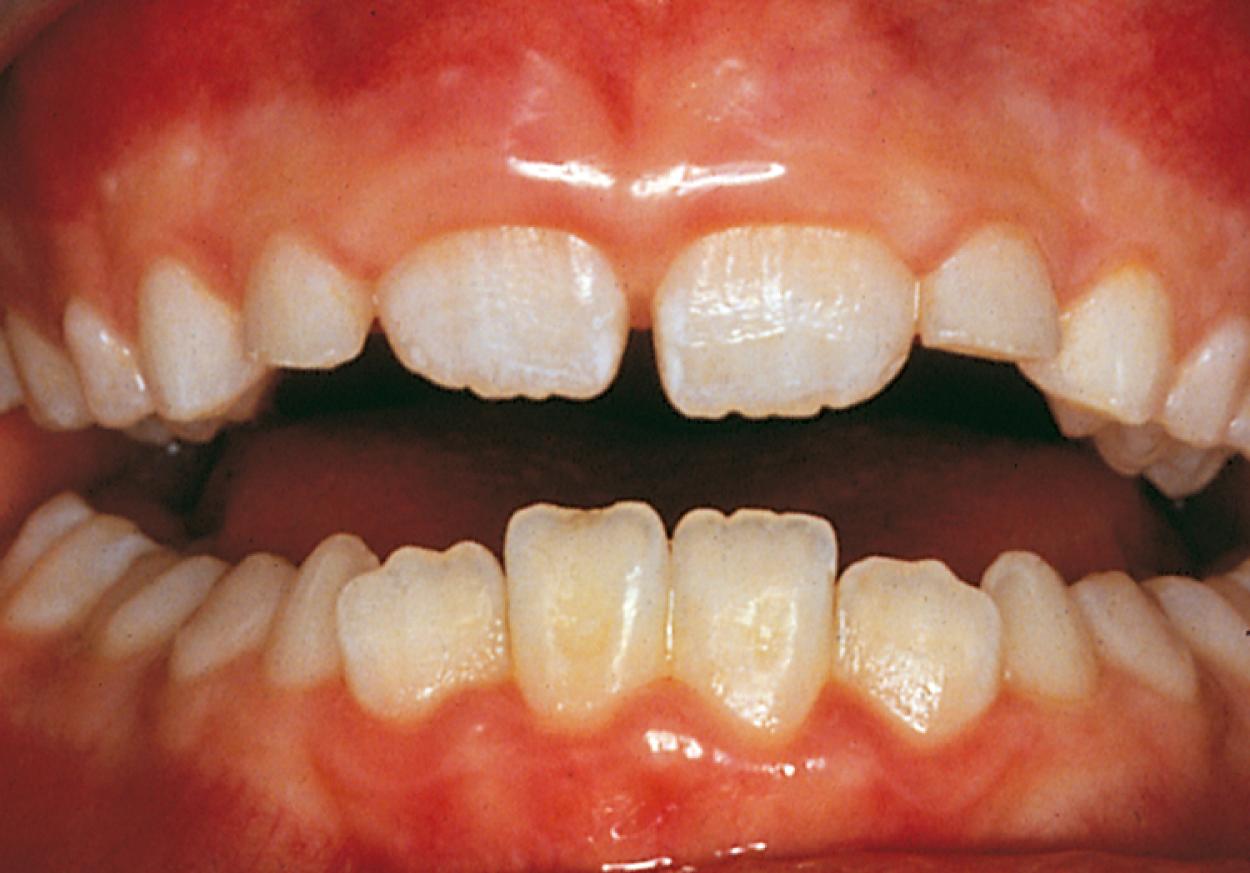
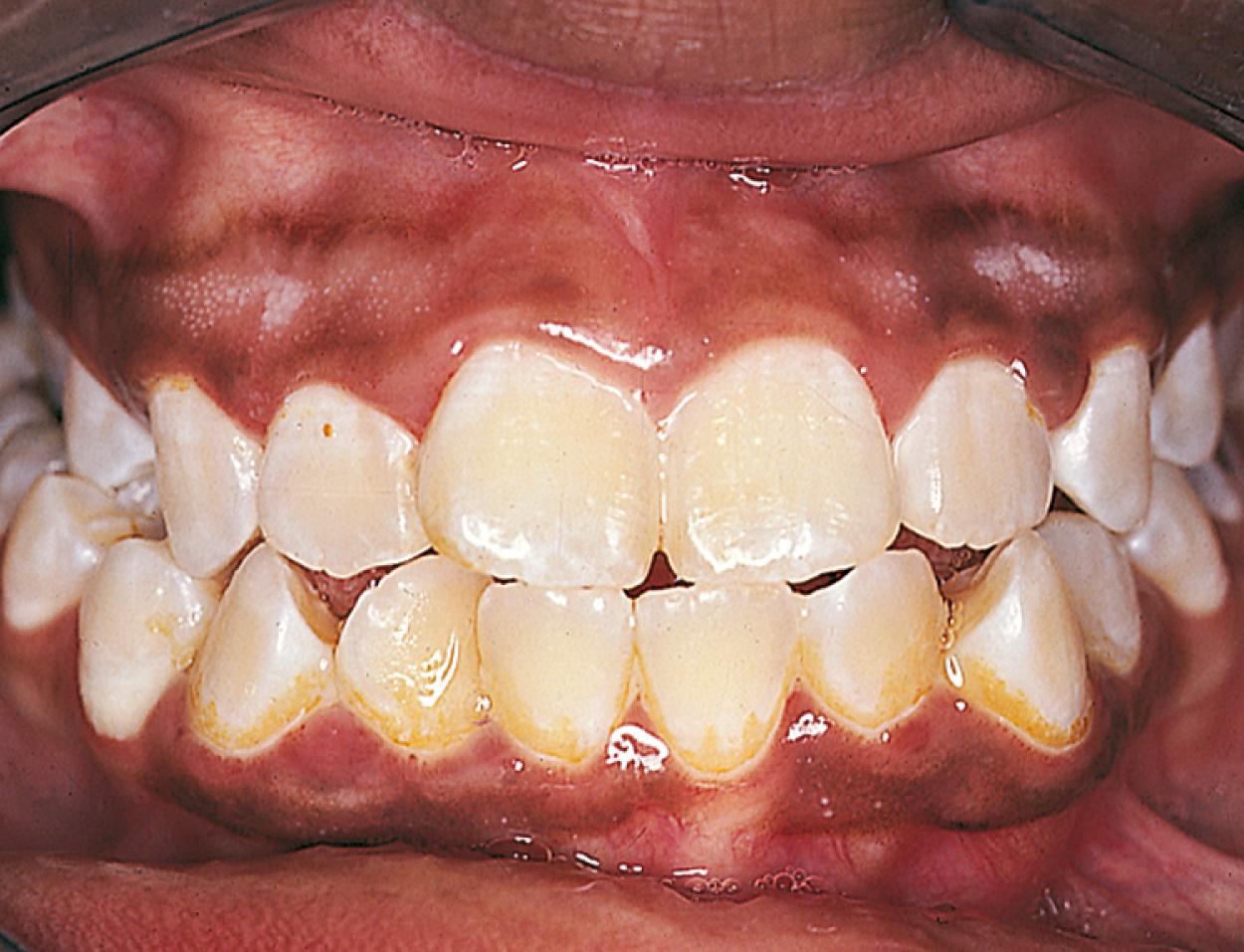
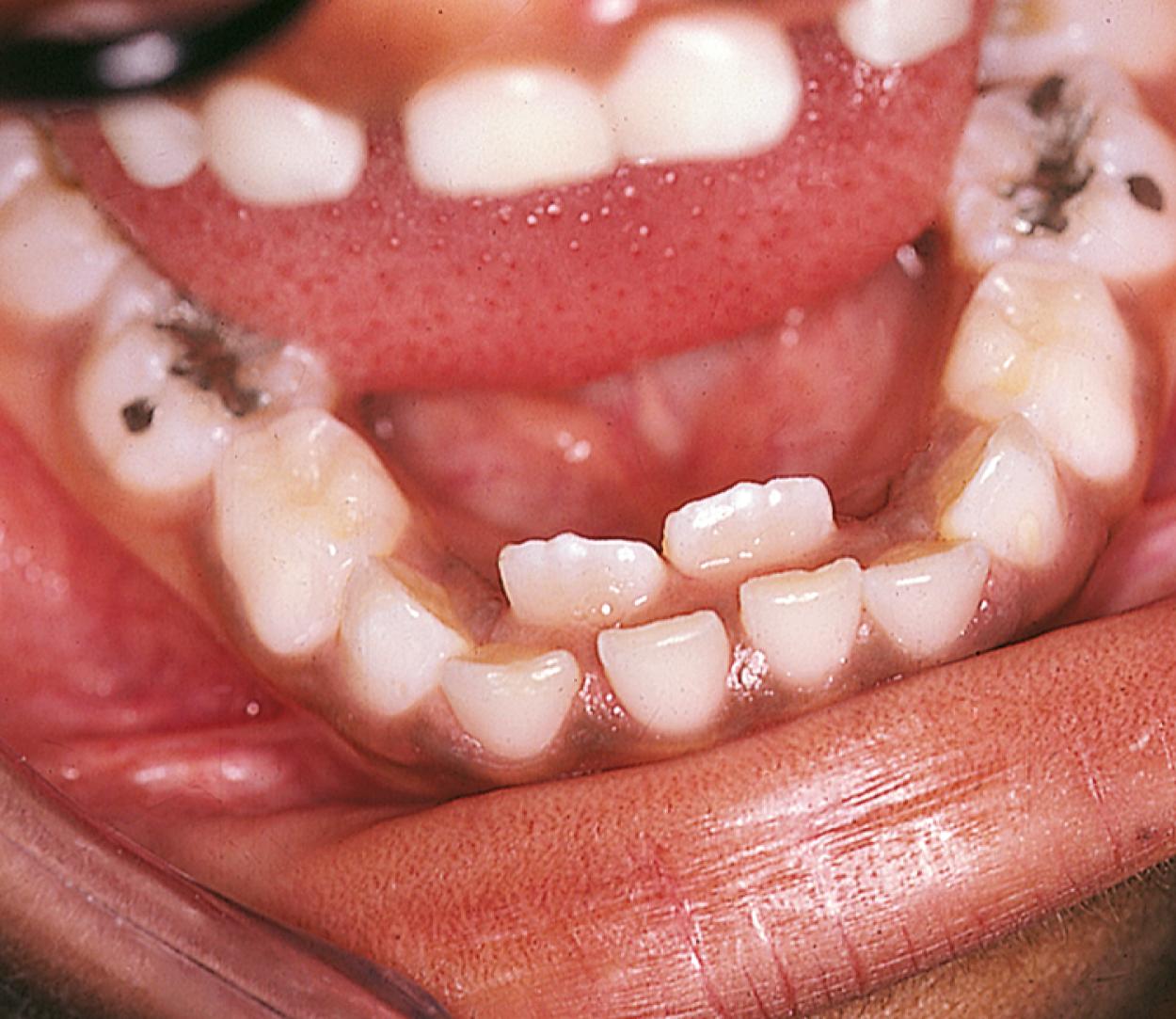
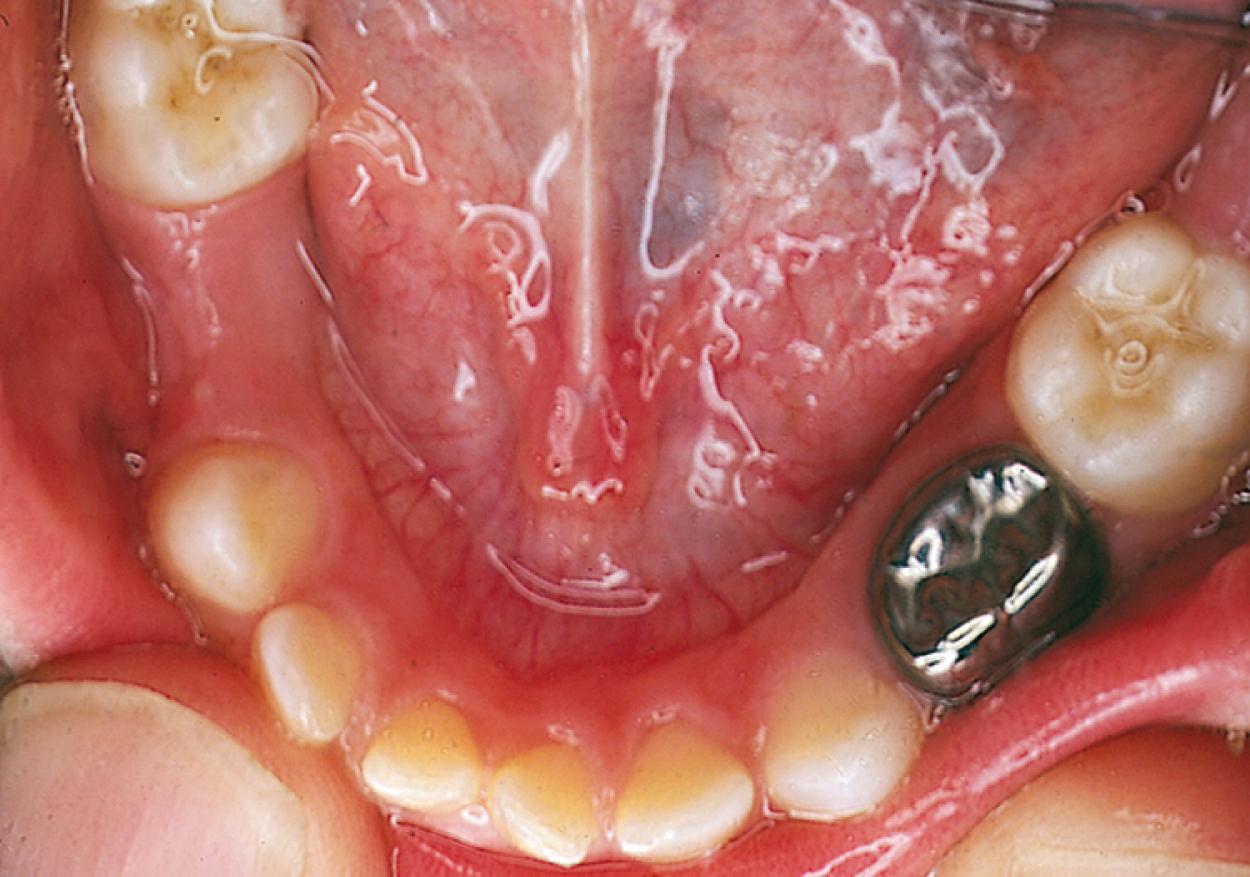
The stage of early permanent dentition marks the beginning of a relatively quiescent period in dental development. Activities are limited to root formation of a few permanent teeth and the calcification of the third molars. By this time, the length and width of the dental arches are well established ( Fig. 21.8 ); however, the jaws undergo a major growth spurt during puberty that alters their size and relative position. The gingiva begins to assume adult characteristics, becoming firm and pink in color, with an uneven, stippled surface texture and a thin gingival margin. Puberty is occasionally associated with gingivitis, which is thought to be secondary in part to hormonal changes ( Fig. 21.9 ). The gingiva becomes mildly edematous and erythematous, and bleeds with brushing. Inattention to careful dental hygiene may also contribute to development of this disorder, which necessitates good oral hygiene for control ( Fig. 21.10 ).
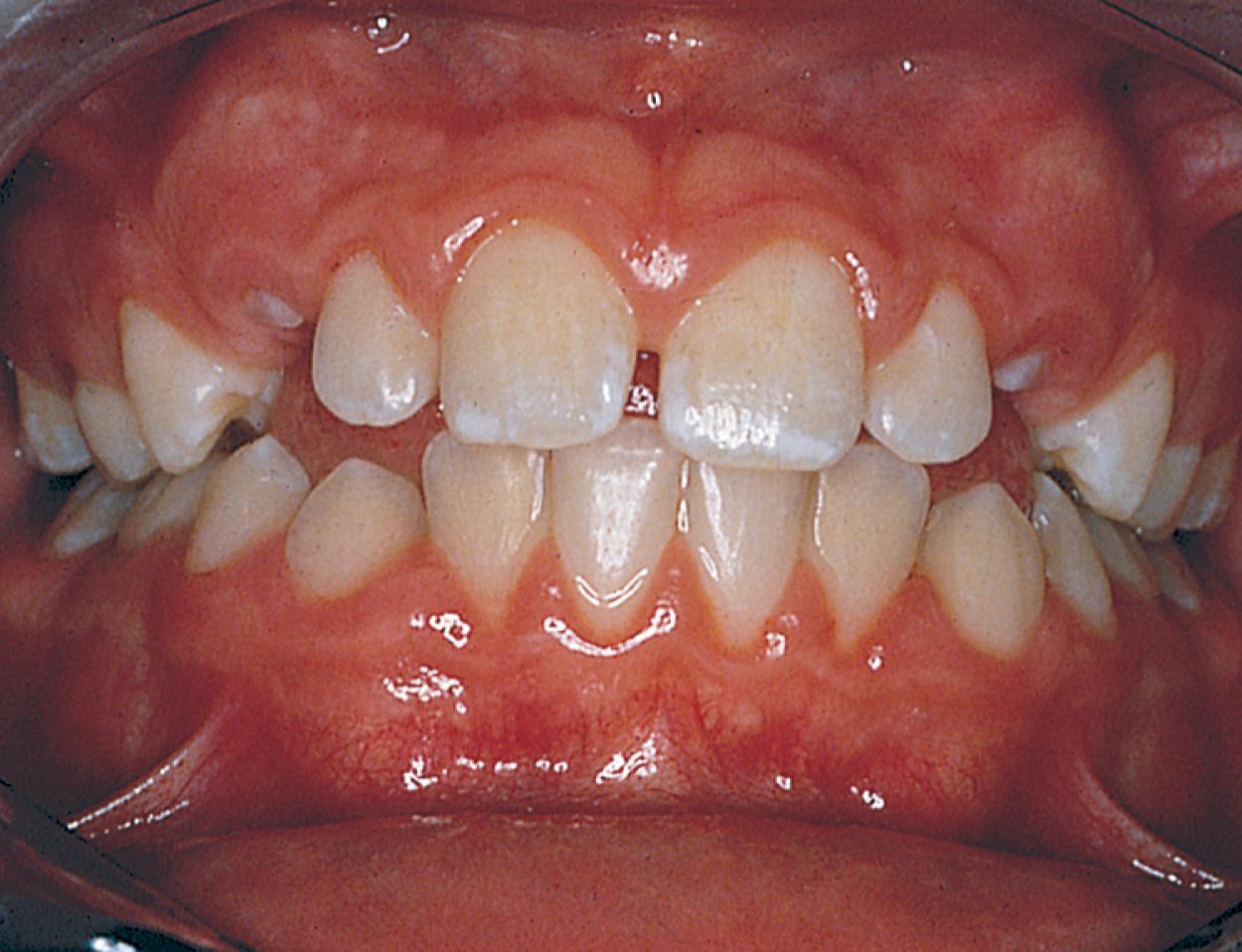
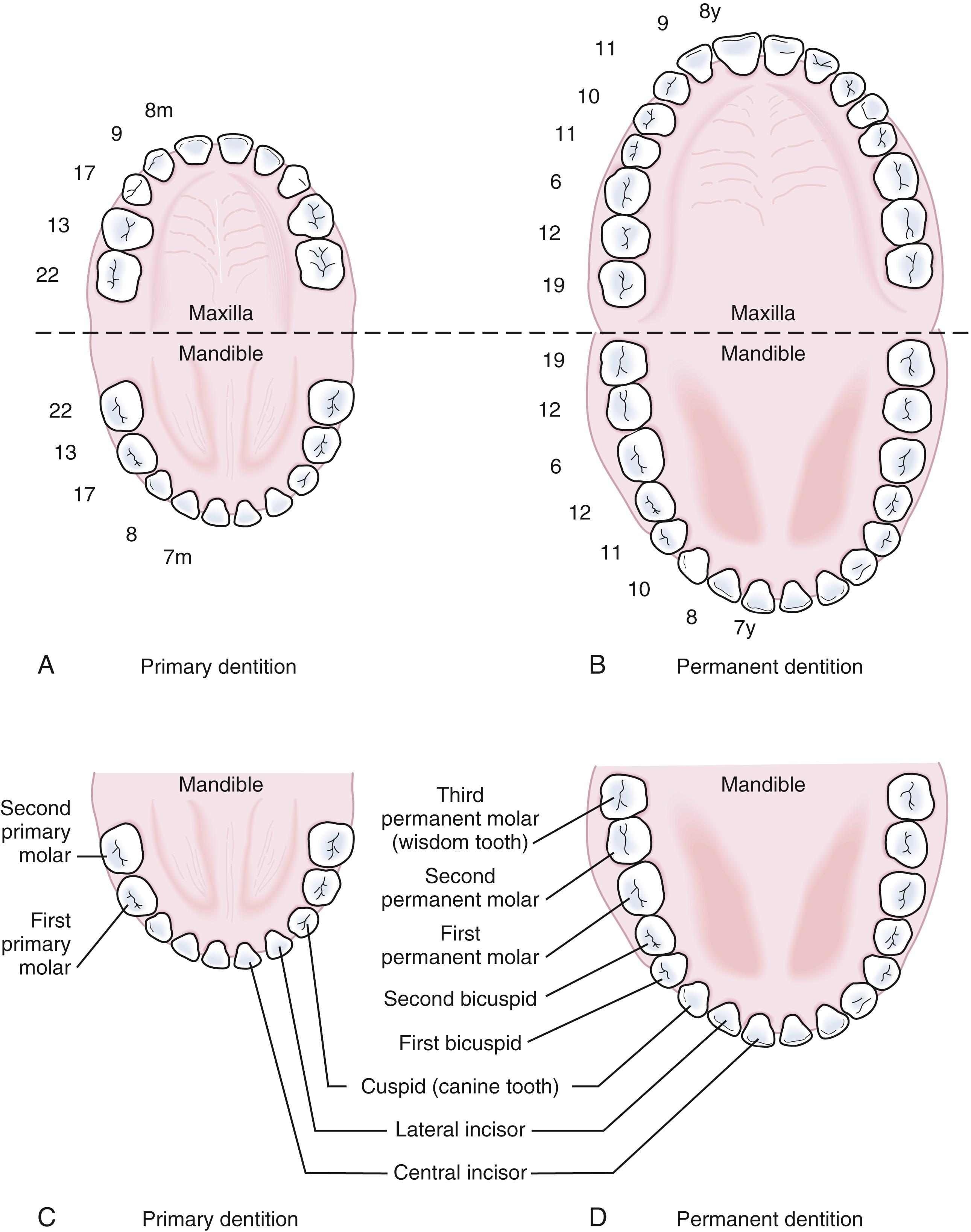
Children often develop sucking habits, using the thumb, finger(s), or objects. Thumb and finger sucking begins antenatally and is considered a normal behavior pattern. However, if the habit persists beyond the late primary dentition stage of dental arch development (5 years), the extrinsic forces applied by the sucking action can produce pathologic changes in the child’s normal arch growth. These deviations range from minor, reversible changes to gross malformations in the dental arches that produce significant anterior open bites and/or posterior crossbites. The degree of change depends on the duration, frequency, and intensity of the sucking habit ( Fig. 21.11 ).
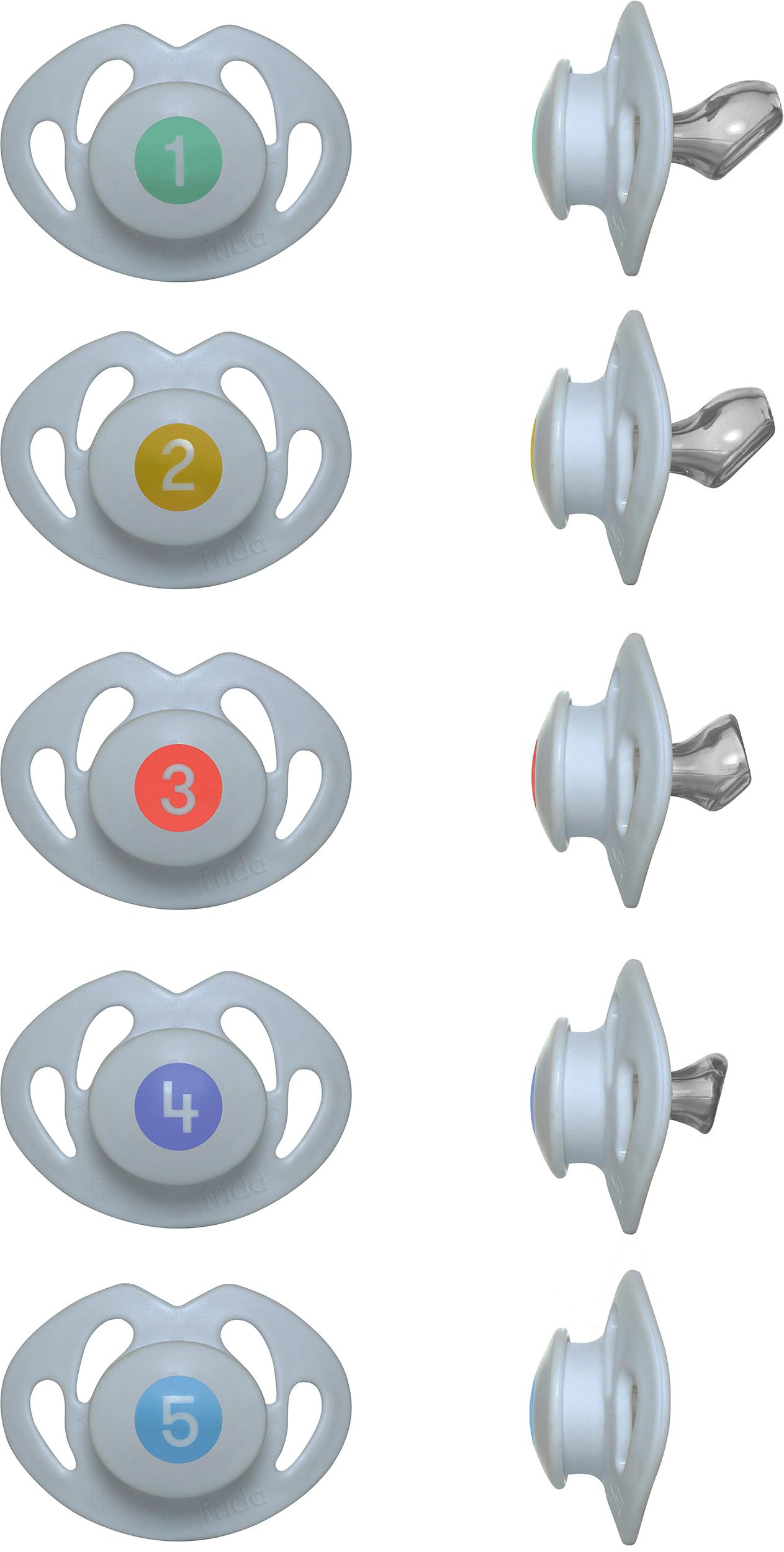
The forces produced by prolonged use of bottles and pacifiers can first cause dental malocclusions and may, if the habit persists, worsen the resulting deformity with the involvement of adjacent jaw structures. Usually, if the child is weaned from the bottle and pacifier by 12 months old, no permanent changes in bite development can be expected. The longer any force is applied, however, the greater the risk that the distortion in the dental arches and adjacent bony structures will not self-correct ( Figs. 21.12 and 21.13 ).
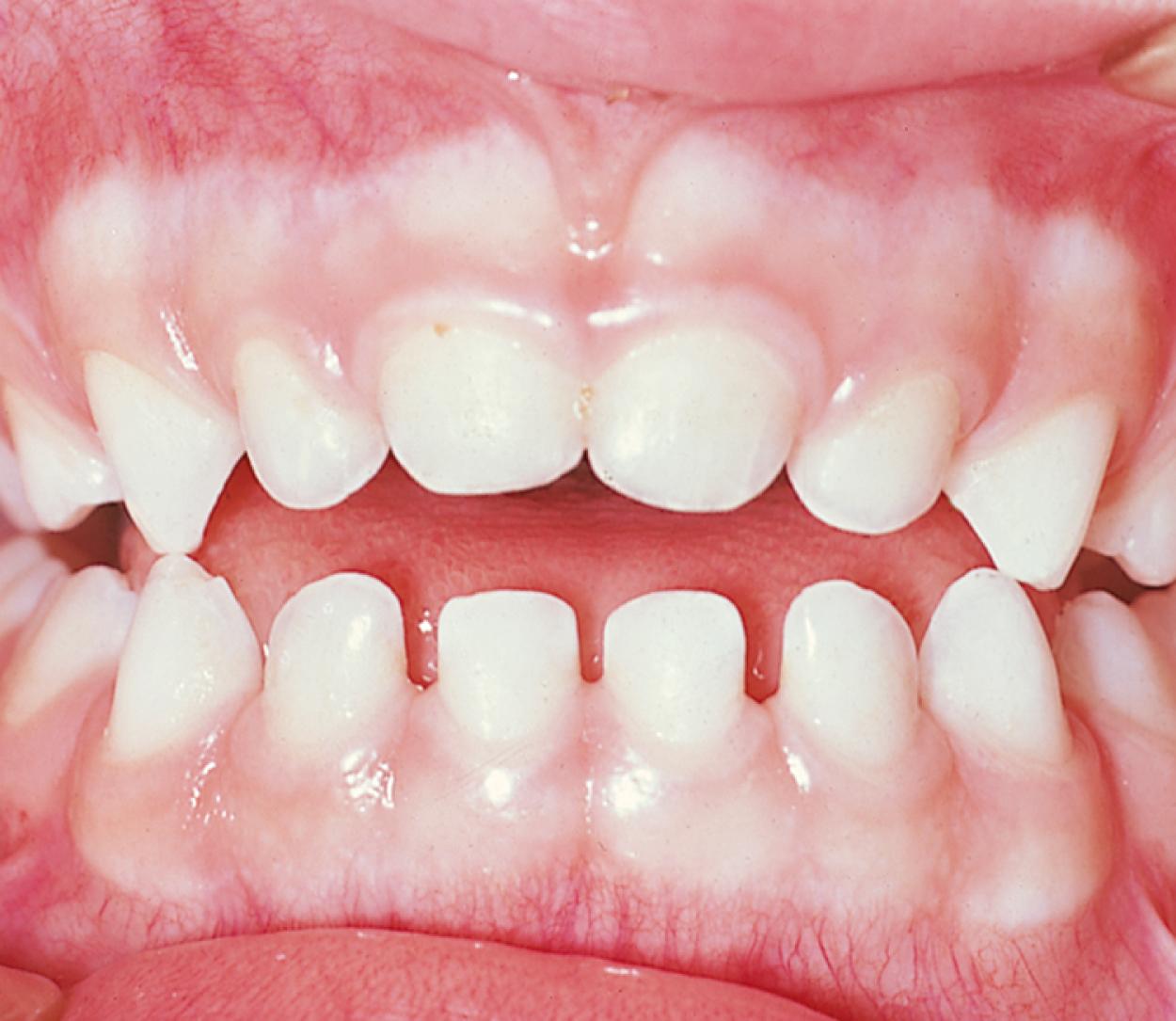
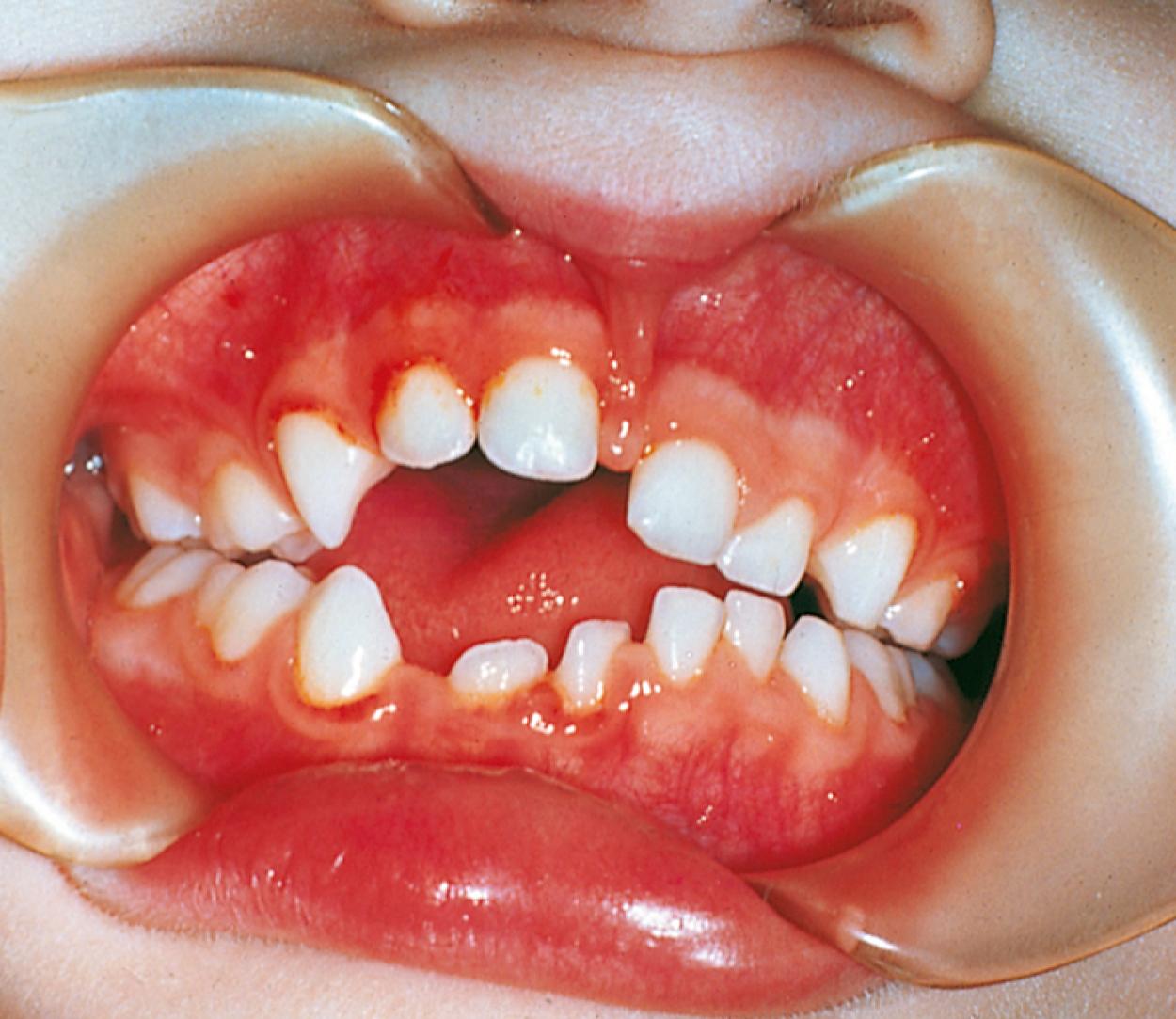
Thus, the use of bottles and pacifiers should be discouraged after 12 months old. Changes in the oral structures have been noted with prolonged use and are more likely to be permanent. The Fridababy Paci Weaning System (see Fig. 21.11 ) is a patented system that can help a child wean from the pacifier in as little as 5 days, using a sequence of pacifiers in a stepwise approach. Counseling parents during the neonatal period not to put their infants to bed with a bottle, but rather to hold them during all feedings, is probably one of the best ways to prevent later difficulties with bottle weaning. Such practices also prevent the development of nursing bottle caries (see Fig. 21.42 ).
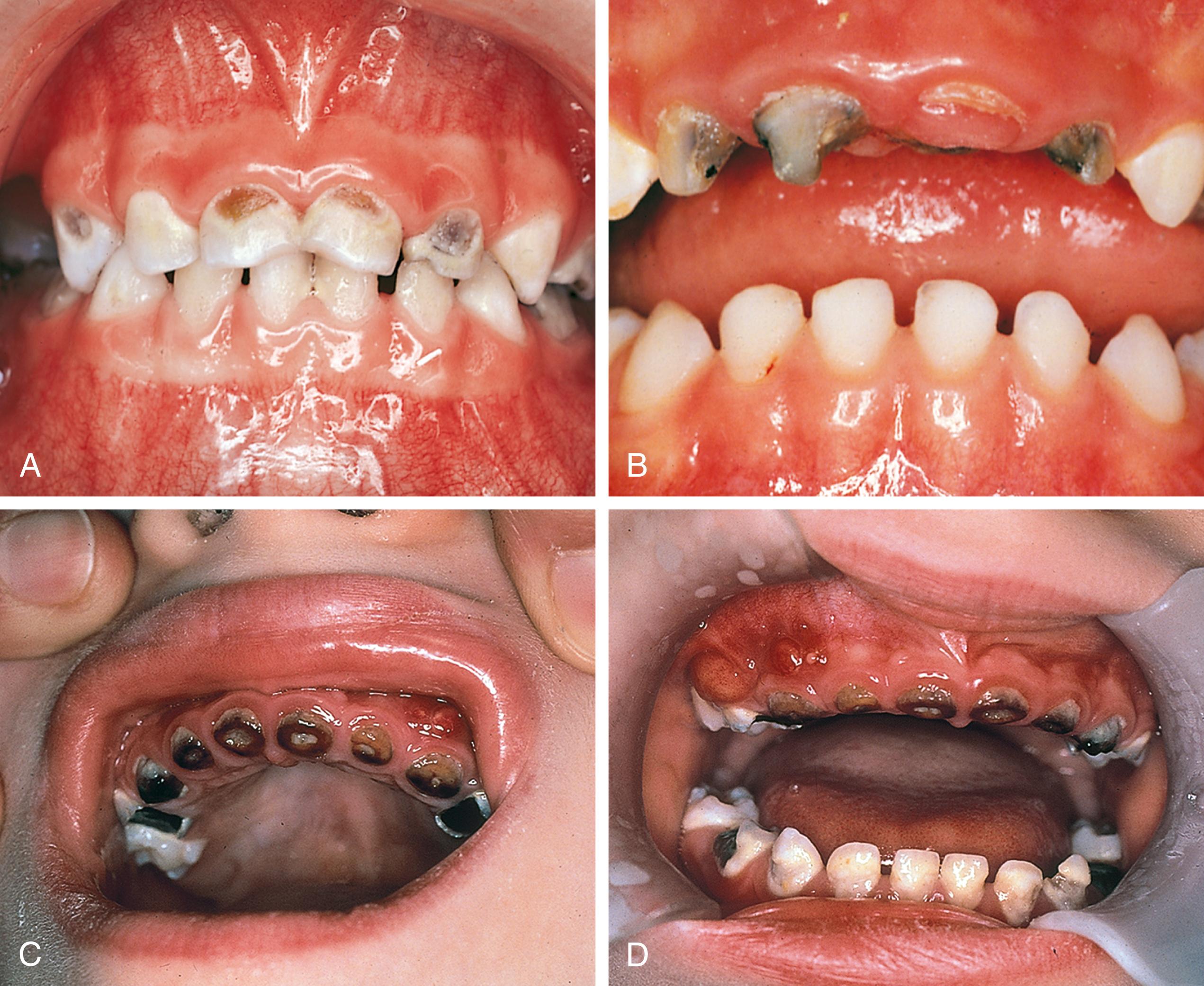
Clinical management of harmful oral habits should be customized to the child’s age. Harsh measures to discourage digit sucking in a 2-year-old are not justified and may be counterproductive. However, when the habit persists beyond a reasonable age, calm discussions with the child concerning feelings related to the sucking and the physical damage possible if it continues often produce the desired results. When a child has expressed a strong will to cease sucking but is unable to accomplish this goal without help, appliance therapy by a dental professional may be indicated. Referral for oral evaluation and consultation is appropriate after the child has passed the appropriate age of the behavior pattern involved.
Teeth that are present in the oral cavity at birth are called natal teeth, whereas those erupting during the neonatal period (30 days after birth) are called neonatal teeth. The incidence of natal teeth has been reported to be approximately 1 in 2000 births. Although seen in normal infants, this anomaly is more frequent in patients with cleft palate ( Fig. 21.14 ) and is often associated with Ellis-van Creveld syndrome, Hallermann-Streiff syndrome, and pachyonychia congenita. Approximately 90% of these are true primary teeth, but occasionally they are supernumerary. Some are abnormal, with either hypoplastic defects or poor crown or root development. Natal teeth may cause feeding problems for both the infant and mother. Ulceration of the ventral surface of the tongue by sharp tooth edges (Riga-Fede disease) may develop if natal teeth remain in the oral cavity. This condition is usually transient, but in persistent cases, symptomatic treatment or extraction of such teeth may be indicated. Most normal-appearing natal teeth can be retained, but those that are supernumerary, abnormal, or very loose may have to be removed to reduce the risk of aspiration and other complications.
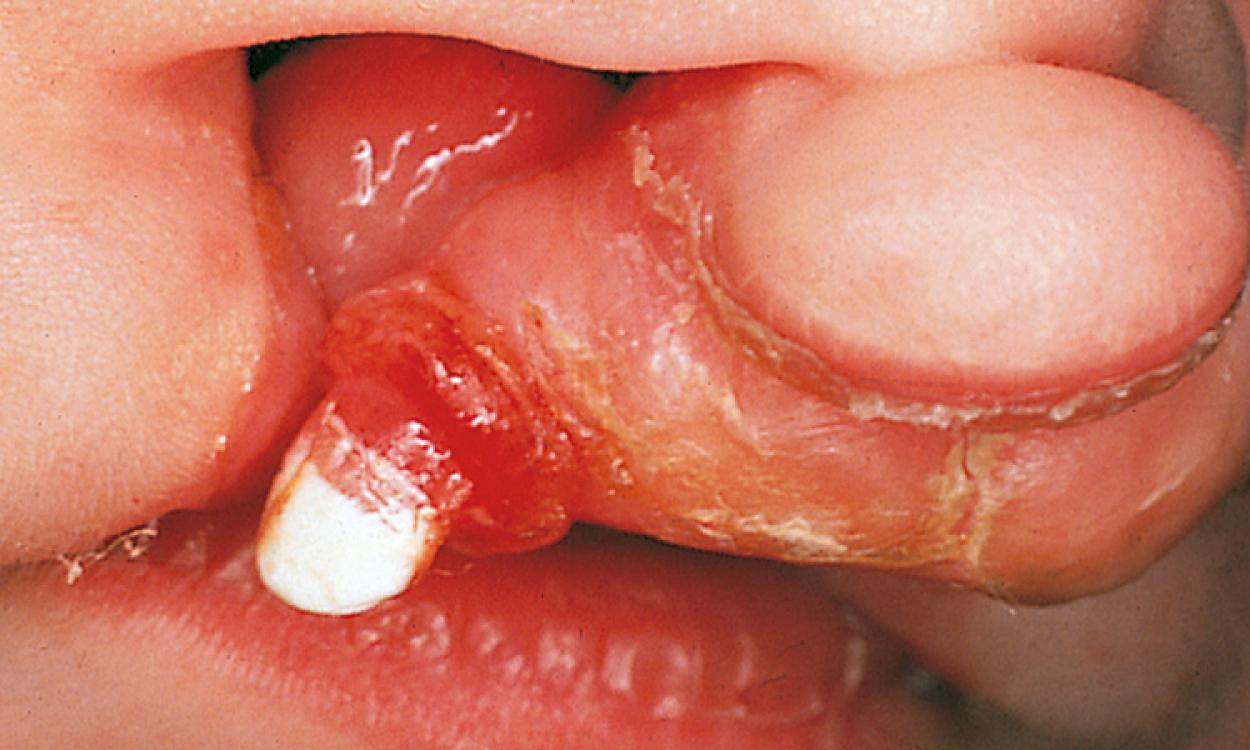
Gingival cysts of the oral cavity are small, single, or multiple superficial lesions that are formed by tissues trapped during embryologic growth. They occur in about 80% of newborns and are asymptomatic, do not enlarge, seldom interfere with feeding, and usually exfoliate within a few weeks.
Three types of cysts exist:
Epstein pearls are keratin-filled cystic lesions lined with stratified squamous epithelium. They appear as small, white lesions along the midpalatine raphe and contain no mucous glands ( Fig. 21.15 ).
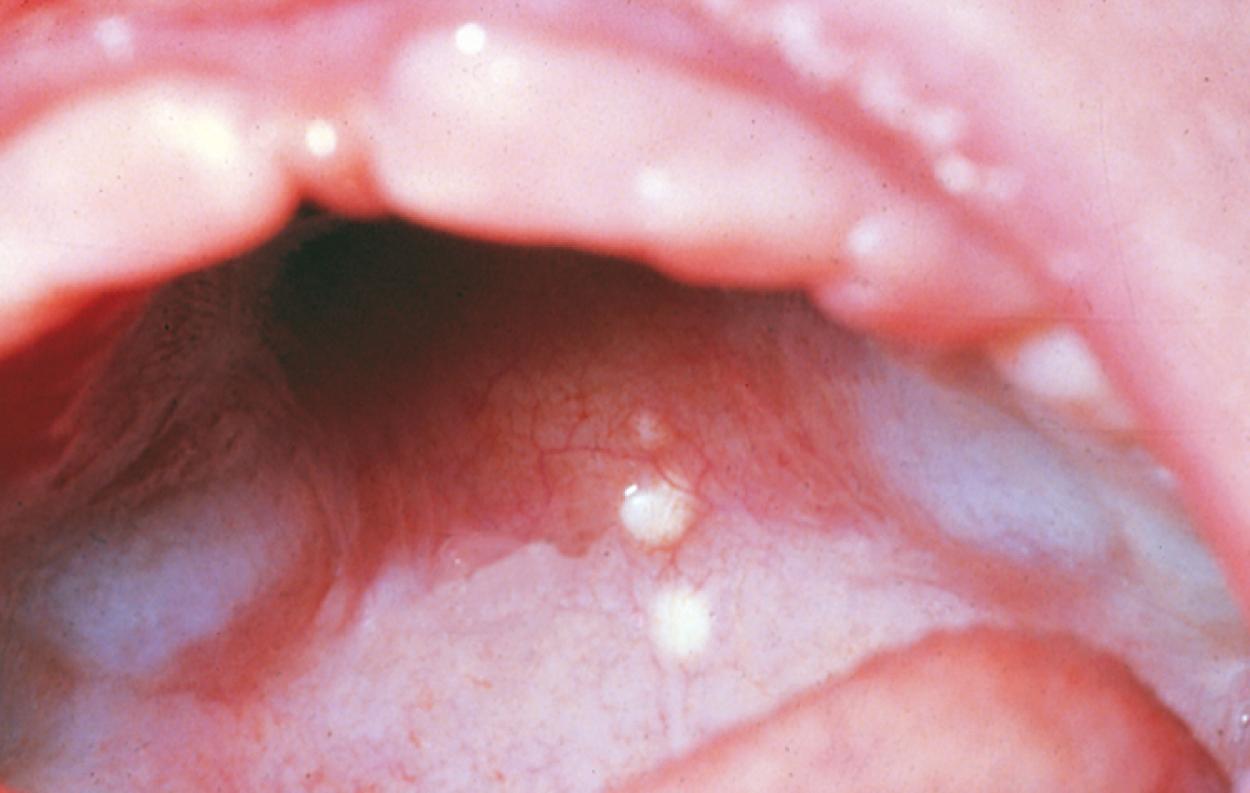
Bohn nodules are mucous gland cysts often found on the buccal or lingual aspects of the alveolar ridges and occasionally on the palate. They are multiple, firm, and grayish white in appearance. Histologically, they show mucous glands and ducts ( Fig. 21.16 ).
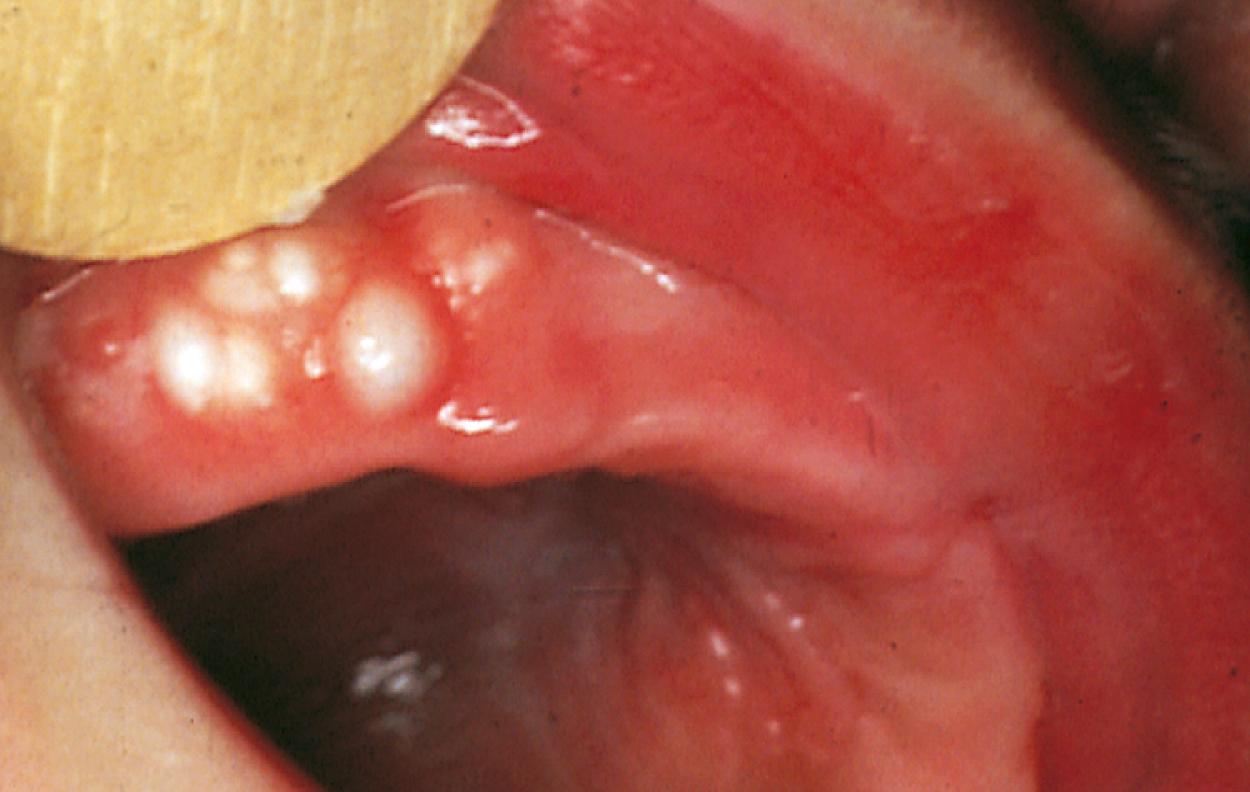
Dental lamina cysts are found only on the crest of the alveolar mucosa. Histologically, these lesions are different because they are formed by remnants of dental lamina epithelium. They may be larger, more lucent, and more fluctuant than Epstein pearls or Bohn nodules, and are more likely to occur singly ( Fig. 21.17 ).
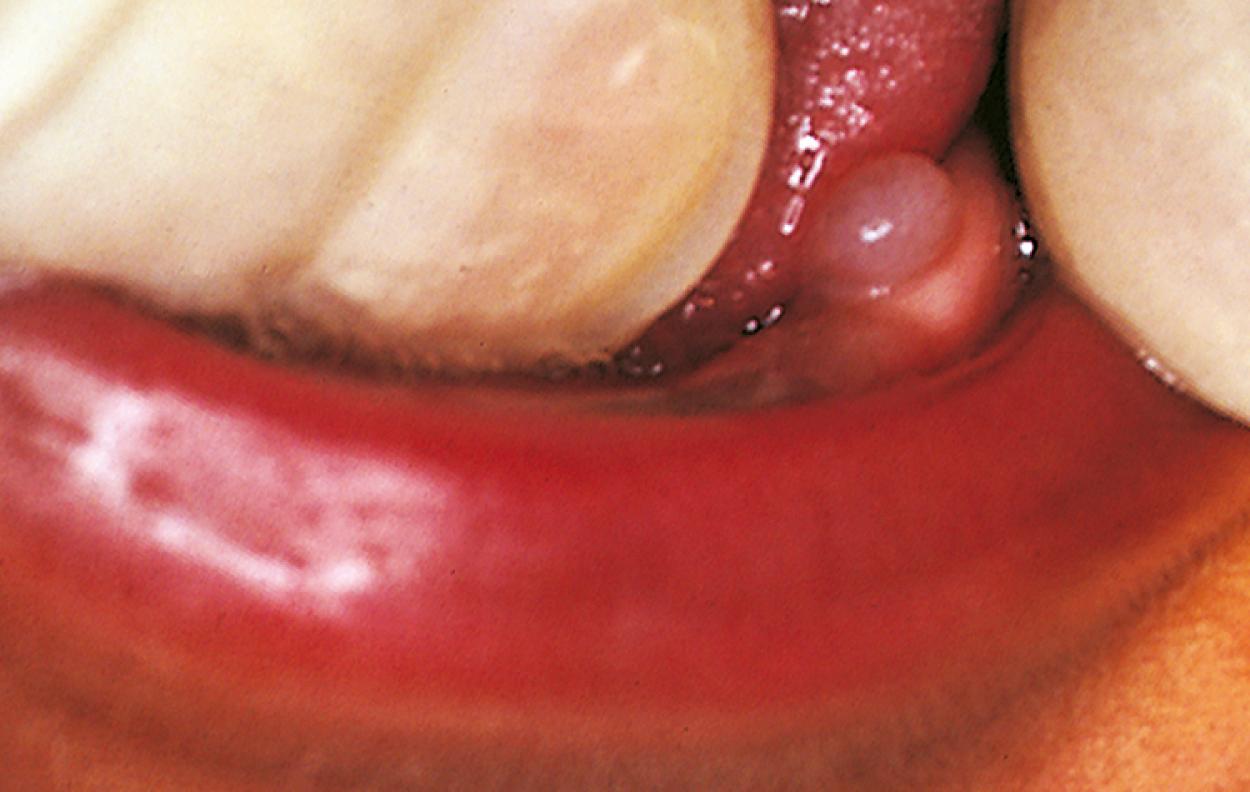
Congenital epulis is a benign, soft tissue tumor seen on the alveolar mucosa at birth or shortly after. It is usually found on the anterior maxilla as a pedunculated swelling ( Fig. 21.18 ), but may appear on the mandible or, occasionally, on both jaws. The mass is firm on palpation and the overlying mucosa appears normal. Histologically, sheets of large granular cells are seen. Differential diagnosis should include rhabdomyoma and melanotic neuroectodermal tumor of infancy. The lesion is amenable to conservative surgical excision, and recurrence is infrequent.
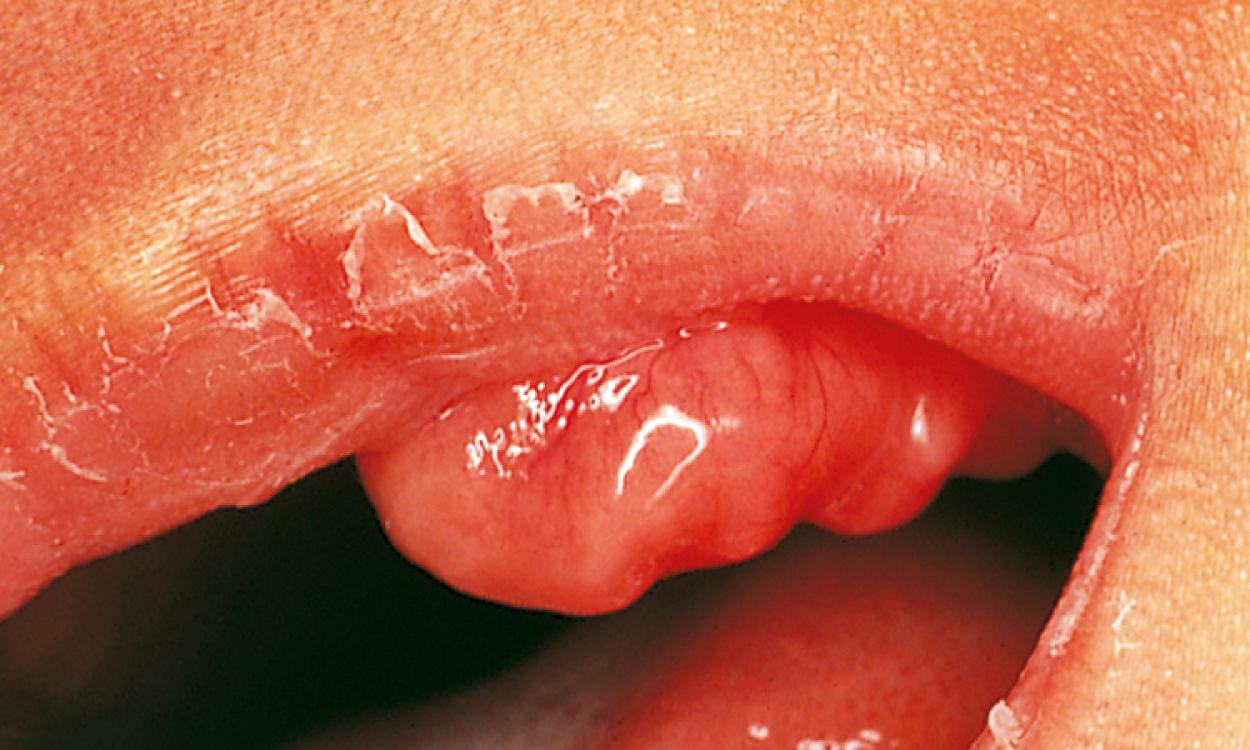
Melanotic neuroectodermal tumor of infancy is a benign yet aggressive tumor, developing during the first year of life and often found on the anterior maxilla in association with unerupted or erupted teeth. It often bulges and destroys the alveolar bone, thus displacing the associated primary tooth. The tumor mass is grayish blue, firm on palpation, and spherical in shape ( Fig. 21.19 ). Careful surgical removal is effective, and recurrence is unusual.
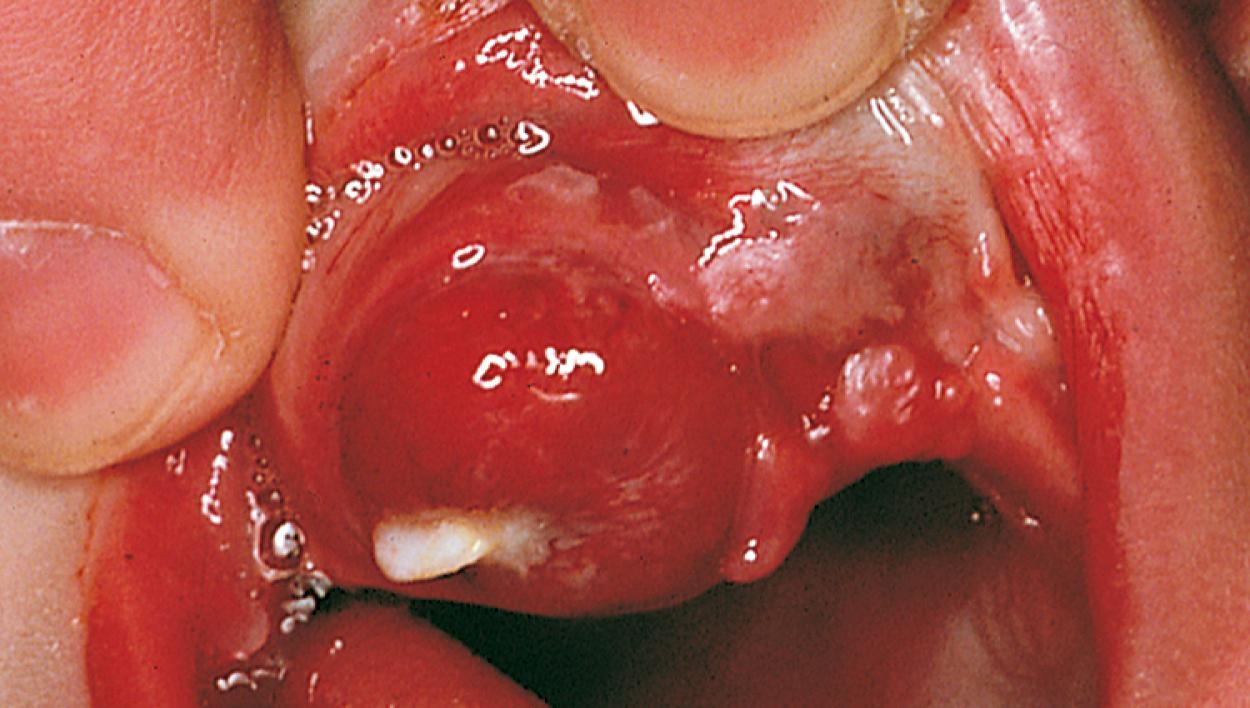
Geographic tongue (benign migratory glossitis) is a condition characterized by inflamed, irregularly shaped areas on the dorsum of the tongue that are devoid of filiform papillae. Although mostly painless, discomfort may be noted when eating spicy or acidic foods. Lesions are red, slightly depressed, and bordered by a whitish band ( Fig. 21.20 ). Spontaneous healing is often followed by formation of similar lesions elsewhere on the tongue, resulting in a migrating appearance. The etiology is unknown; however, a strong association with stress and allergic disease is suspected. Although benign, the course of this disorder may be prolonged for months, and it may recur.
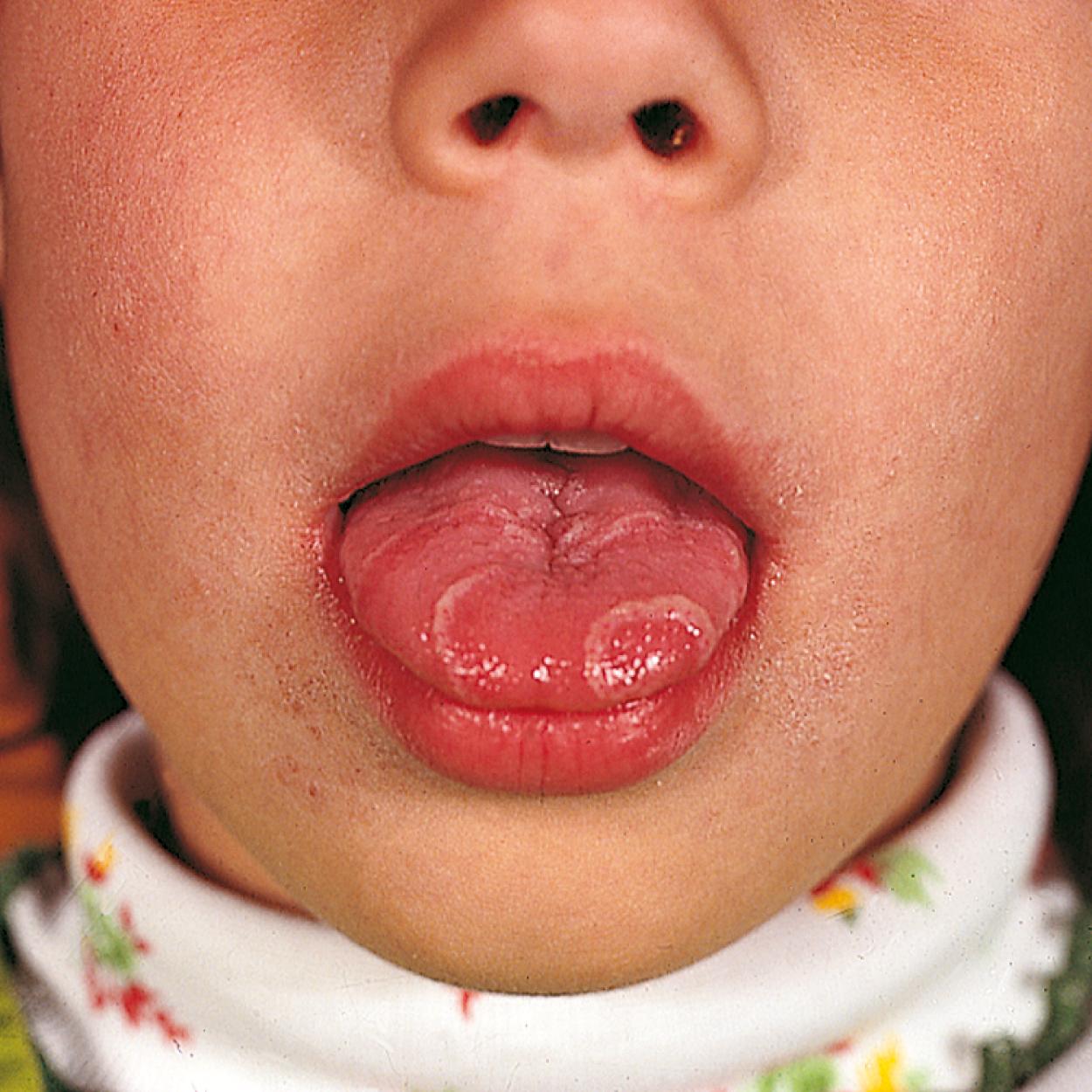
During embryonic life, the maxillary labial frenulum extends as a band of tissue from the upper lip over and across the alveolar ridge and into the incisive (palatine) papilla. Postnatally, as the alveolar process increases in size, the labial frenulum separates from the incisive papilla and becomes relatively smaller. With the eruption of primary and later permanent teeth, the frenulum attachment moves apically and further atrophies as a result of vertical growth of the alveolar process. The developmental gap (diastema) between the maxillary central incisors tends to close with the full eruption of the maxillary permanent canines. The diastema is often present and is considered normal in primary teeth dentition. Rarely is a labial frenum addressed during the primary dentition stage, but surgical intervention may be considered in the presence of gross caries due to food impaction in the vestibule. On occasion, the maxillary frenulum fails to atrophy as a child matures and the diastema persists ( Fig. 21.21 ). This may require intervention, but it is largely recommended to only do so surgically after the permanent canines have erupted and post-orthodontia. The mandibular midline frenulum only rarely maintains a lingual extension, and therefore rarely causes a diastema between the mandibular central incisors; however, with an insertion on the free or marginal gingiva, it can cause pulling of fibers leading to pocket formation and plaque accumulation. Early treatment can be considered for labial frenum release, but more noninvasive interventions such as increased oral hygiene practices and plaque control, along with other preventative measures, are highly recommended prior to surgical intervention.
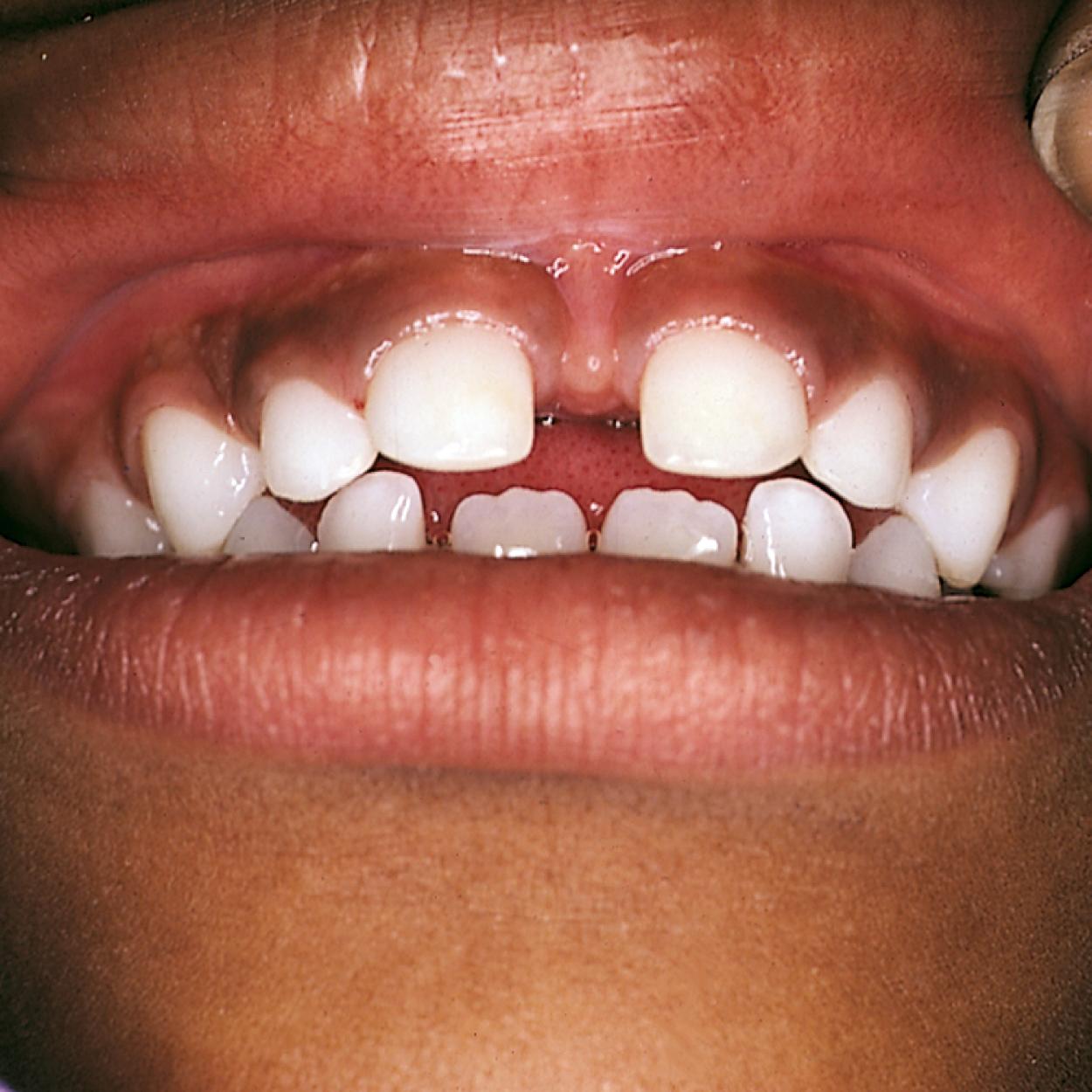
The lingual frenulum extends almost to the tip of the tongue in early infancy and then gradually recedes. On occasion, ankyloglossia (tongue tie) is seen ( Fig. 21.22 ) and can be associated with feeding difficulties but is rarely associated with speech difficulties. Various surgical procedures have been advocated to correct this condition, but there is controversy regarding when to proceed with surgical intervention. According to the AAPD, the tongue’s ability to elevate rather than protrude is the most important feature of tongue mobility; a restrictive lingual frenum can cause an ineffective latch during breastfeeding but is often less of an issue with bottle-feeding. This ineffective latch can lead to early cessation of breastfeeding, which the AAP recommends as the exclusive source of nutrition for the first six months of an infant’s life. In the presence of ineffective feeding, early tongue tie release (within the first several weeks of life) can be effective for increasing feeding function.
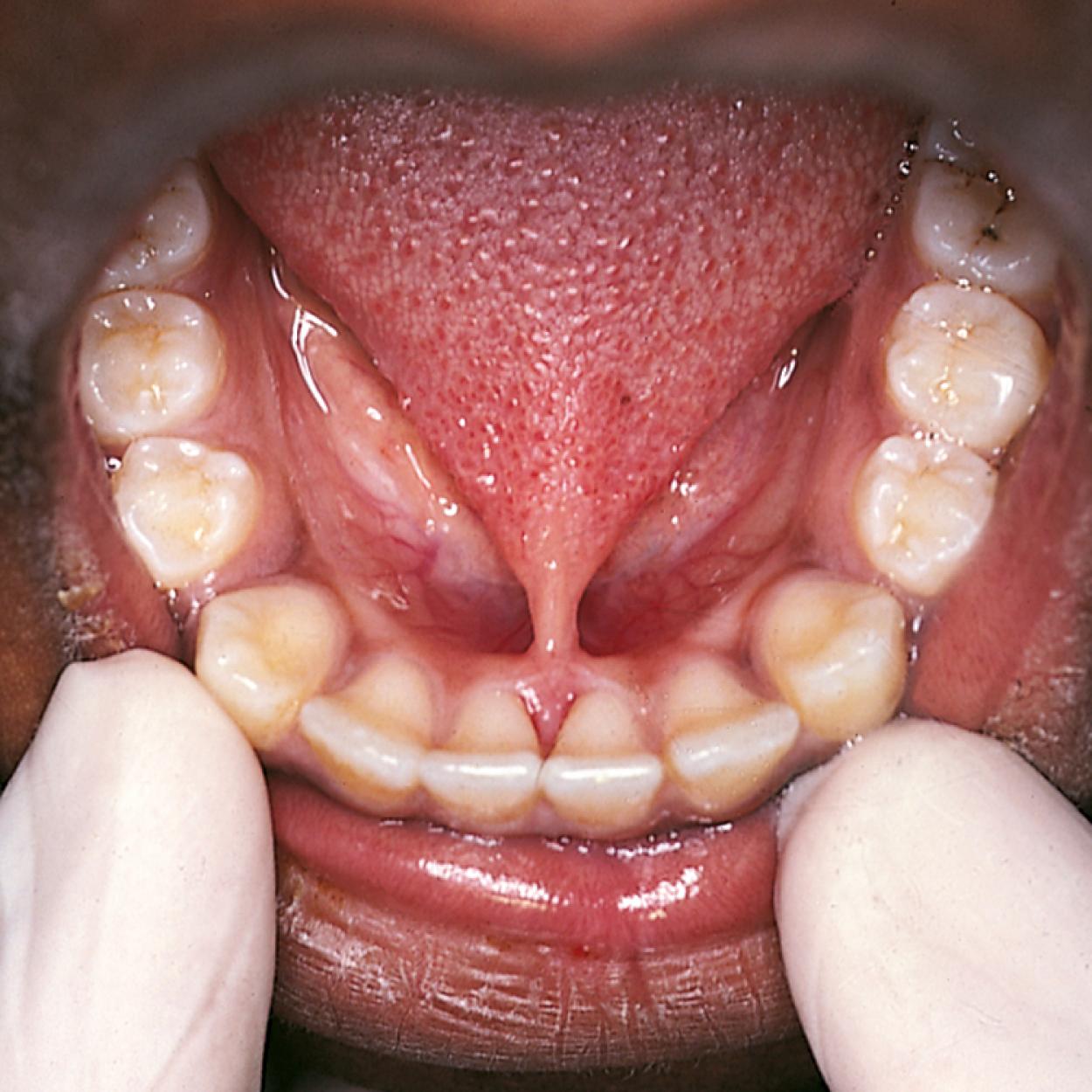
With regard to speech difficulties in a child, evaluation by a speech-language pathologist trained in assessing tongue ties is recommended to assess for speech or language errors prior to tongue-tie release to alleviate speech concerns. In general, frenulectomy is seldom indicated and should be recommended only after appropriate justification. Congenital anomalies may include an enlarged frenulum, labiolingual frenulum extensions, or supernumerary frenula as seen in orofaciodigital syndrome ( Fig. 21.23 ).
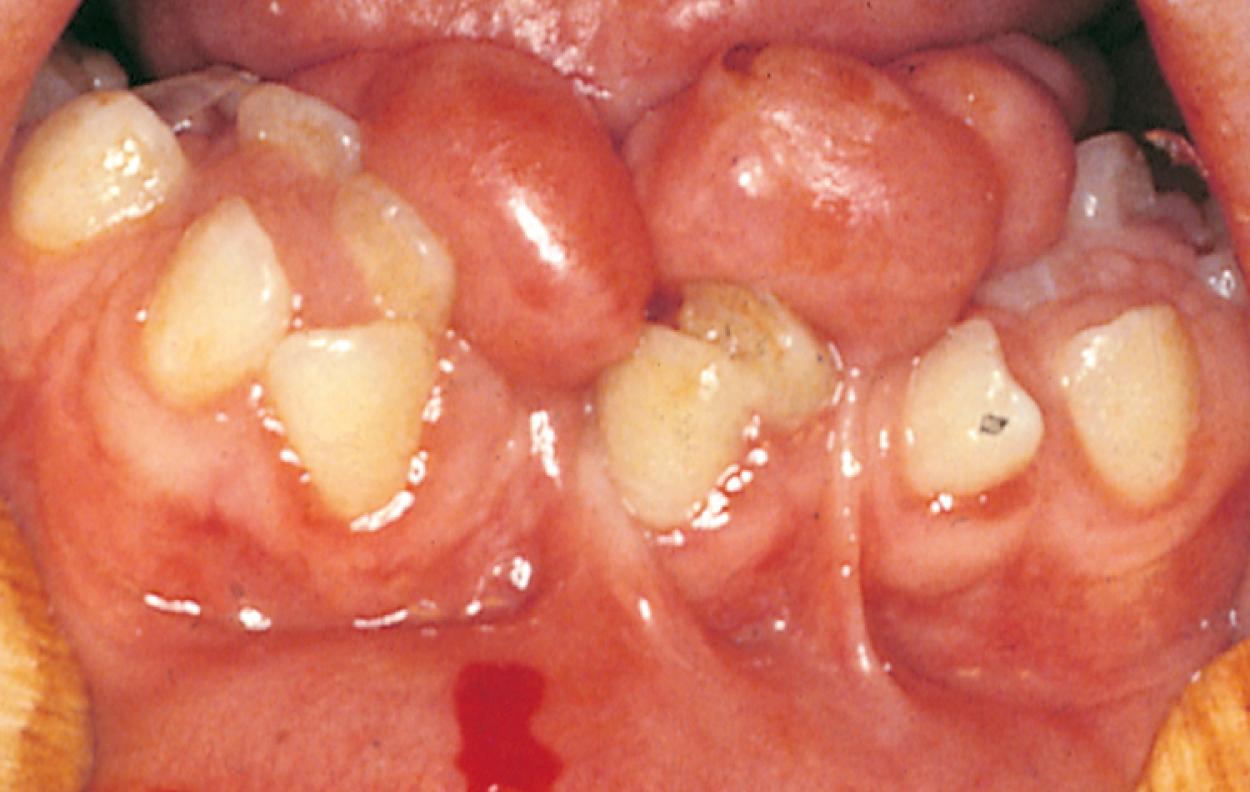
Generalized gingival hyperplasia is a fairly common nonspecific pathologic entity. This disorder is frequently a complication of drug therapy, specifically from phenytoin and cyclosporine. Gingival hyperplasia may also be idiopathic or genetically transmitted as in hereditary gingival fibromatosis. Differentiation of various types of hyperplasia must be based on thorough physical evaluation and appropriate medical history. Histopathologically, it is impossible to differentiate among these various disorders; therefore the final diagnosis and recommendations for therapy should be based on all available clinical data and an appropriate dental consultation.
The administration of phenytoin over a period of time frequently causes generalized hyperplasia of the gingiva ( Fig. 21.24 ). The gingiva may become secondarily inflamed, edematous, and boggy, especially if proper oral hygiene is not practiced. The severity is often related to the degree of local irritation, stemming from poor oral hygiene, mouth breathing, caries, or poor occlusion (alignment). Because hyperplasia tends to recur after surgical excision, gingivectomy is usually reserved for those patients whose overgrowth interferes with function, or for those whose phenytoin therapy has been modified or discontinued.
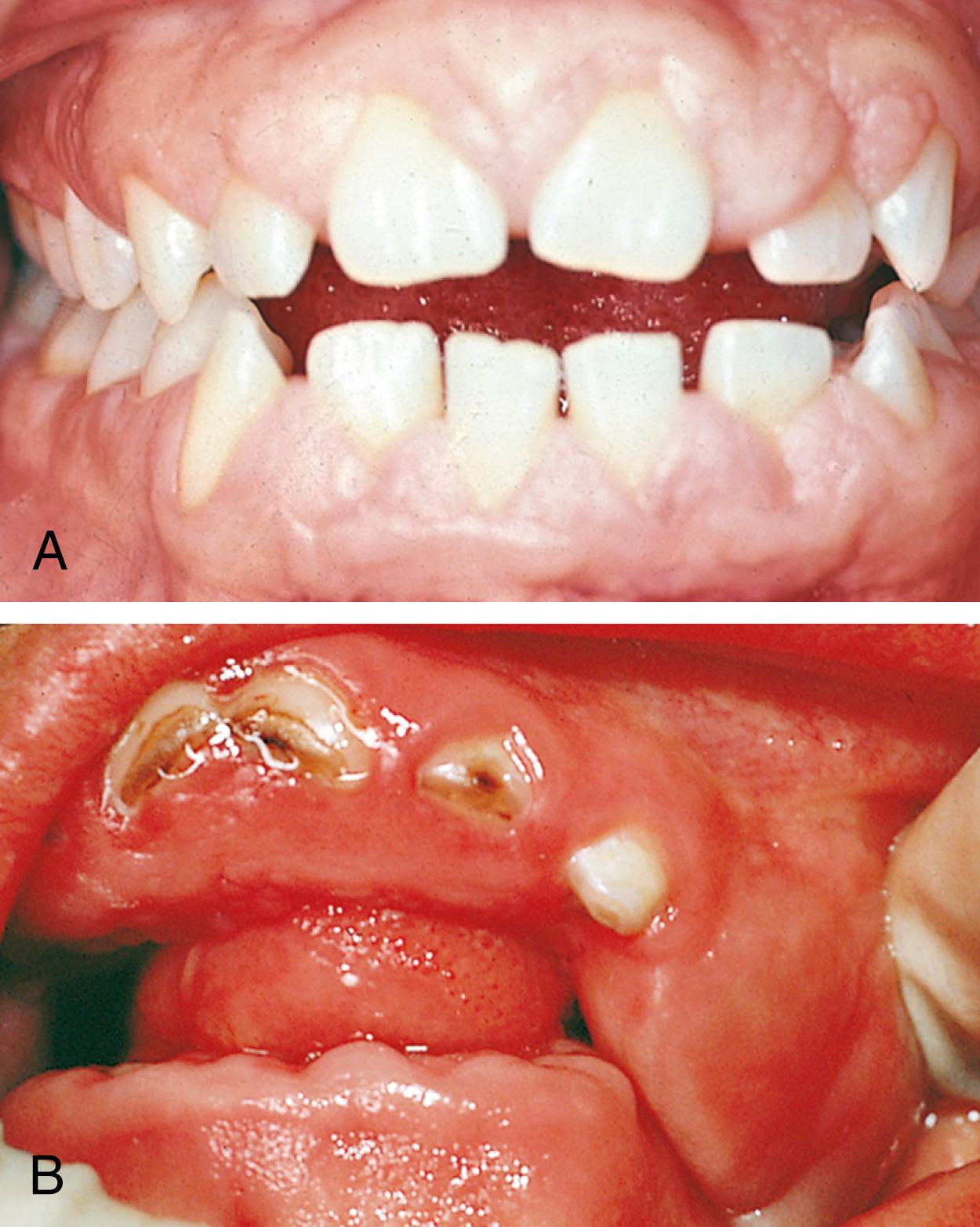
Cyclosporine has been used primarily to treat patients after organ transplantation. The drug has been demonstrated to directly increase cellular growth of gingival fibroblasts. It also increases the production and retention of collagen. Further, this agent’s immunosuppressive action may predispose gingival tissues to invasion by microorganisms, thereby increasing inflammatory changes. Although meticulous oral hygiene reduces inflammation, it has no significant effect on the degree of hyperplasia.
Gingival fibromatosis, a rare, genetically determined condition, may be clinically evident at birth; in such instances it may prevent or slow subsequent dental eruption. Clinically, it manifests as the generalized presence of firm fibrous tissue that extends around the crowns of involved teeth. Inflammation, when present, is usually secondary. Surgical excision of excessive tissues is usually indicated, but recurrence is a possibility.
Patients, often with significant systemic illnesses or syndromes, may manifest generalized gingival enlargements. These may primarily involve the gingival tissues or may sometimes be related to underlying thickening of cortical bone, which causes gingival hyperplasia by impeding dental eruption. Each of these cases must be evaluated individually for possible etiology and appropriate treatment.
An eruption cyst is a fluid-filled, nontender swelling that covers the crown of an erupting tooth. When the follicle is dilated with blood, the lesion takes on a bluish color and is termed an eruption hematoma ( Fig. 21.25 ). Although the eruption cyst is a superficial form of dentigerous cyst, it rarely impedes eruption. Surgical exposure of the crown is seldom necessary. Rarely, such a cyst may become secondarily infected. In such cases, patients complain of headache or facial pain, and the cyst is tender on palpation. Incision and drainage are required typically when infection has developed.
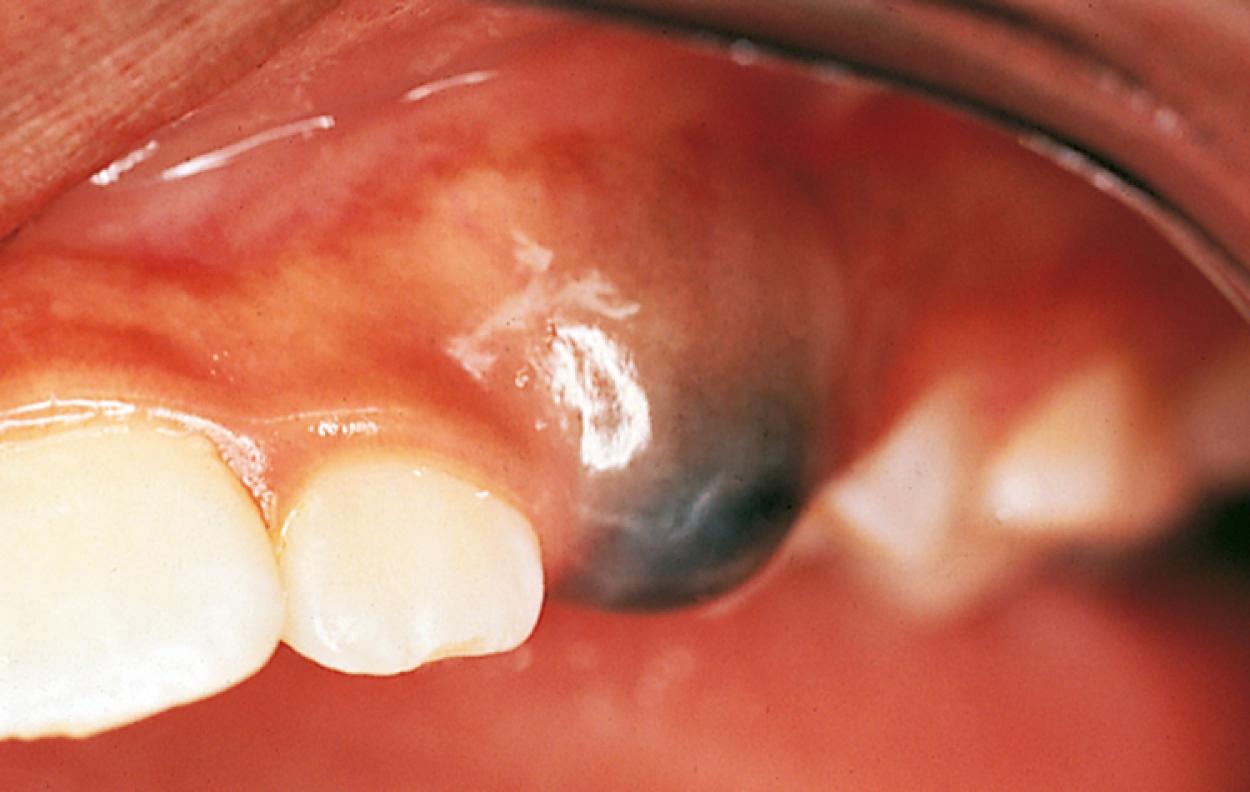
A mucocele is a painless, translucent or bluish lesion of traumatic origin, most often involving minor salivary glands of the lower lip ( Fig. 21.26 ). The lesion may alternately enlarge and shrink. The treatment of choice is surgical excision of the lesion and the associated minor salivary gland.
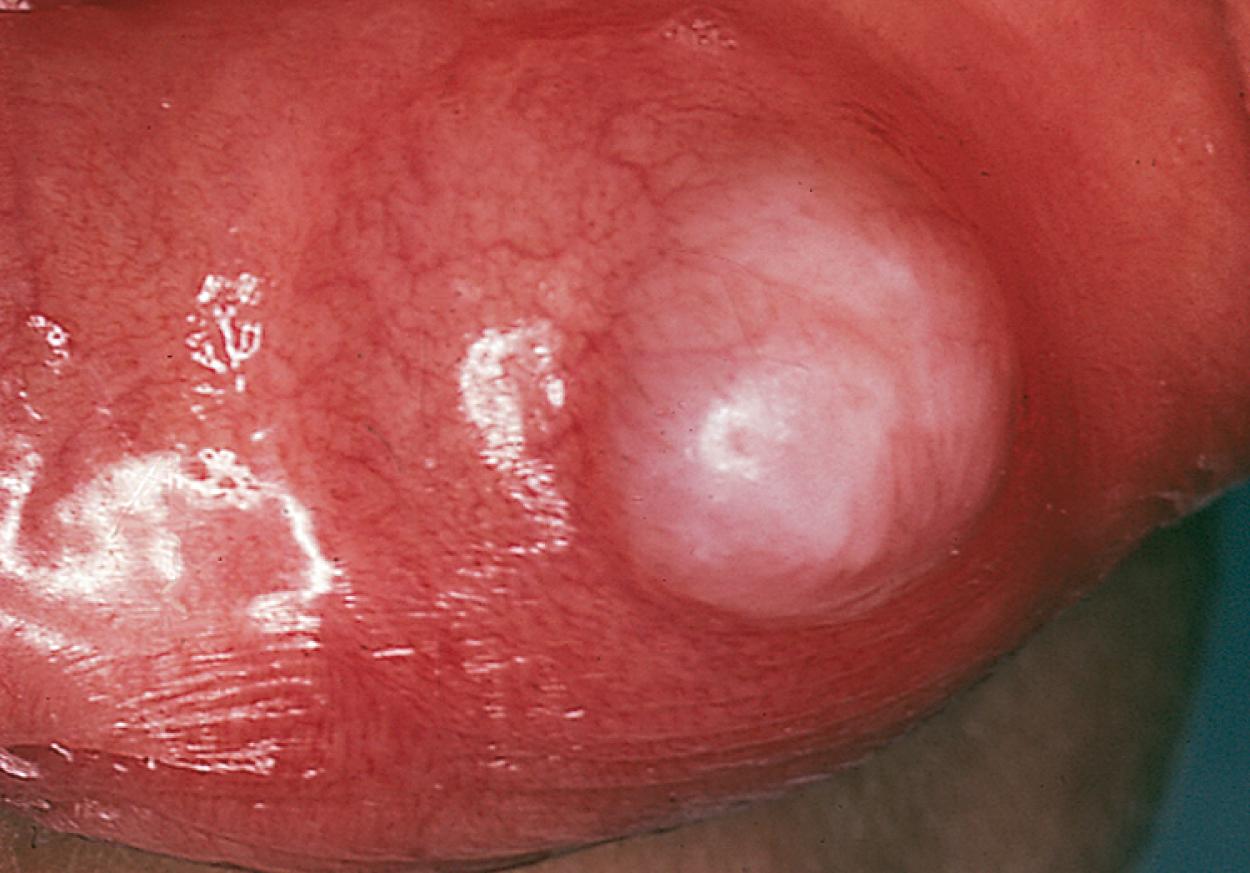
A simple ranula is a retention cyst in the floor of the mouth that is confined to sublingual tissues superior to the mylohyoid muscle. It appears clinically as a bluish, transparent, thin-walled, fluctuant swelling ( Fig. 21.27 ). Herniation of the ranula through the mylohyoid muscle results in a cervical or plunging ranula that becomes more apparent in the oral cavity with the muscle contraction associated with jaw opening. Simple incision and drainage of the ranula is not an acceptable treatment, because healing is followed by recurrence; the ranula must be removed in its entirety, along with the associated salivary gland to avoid recurrence.
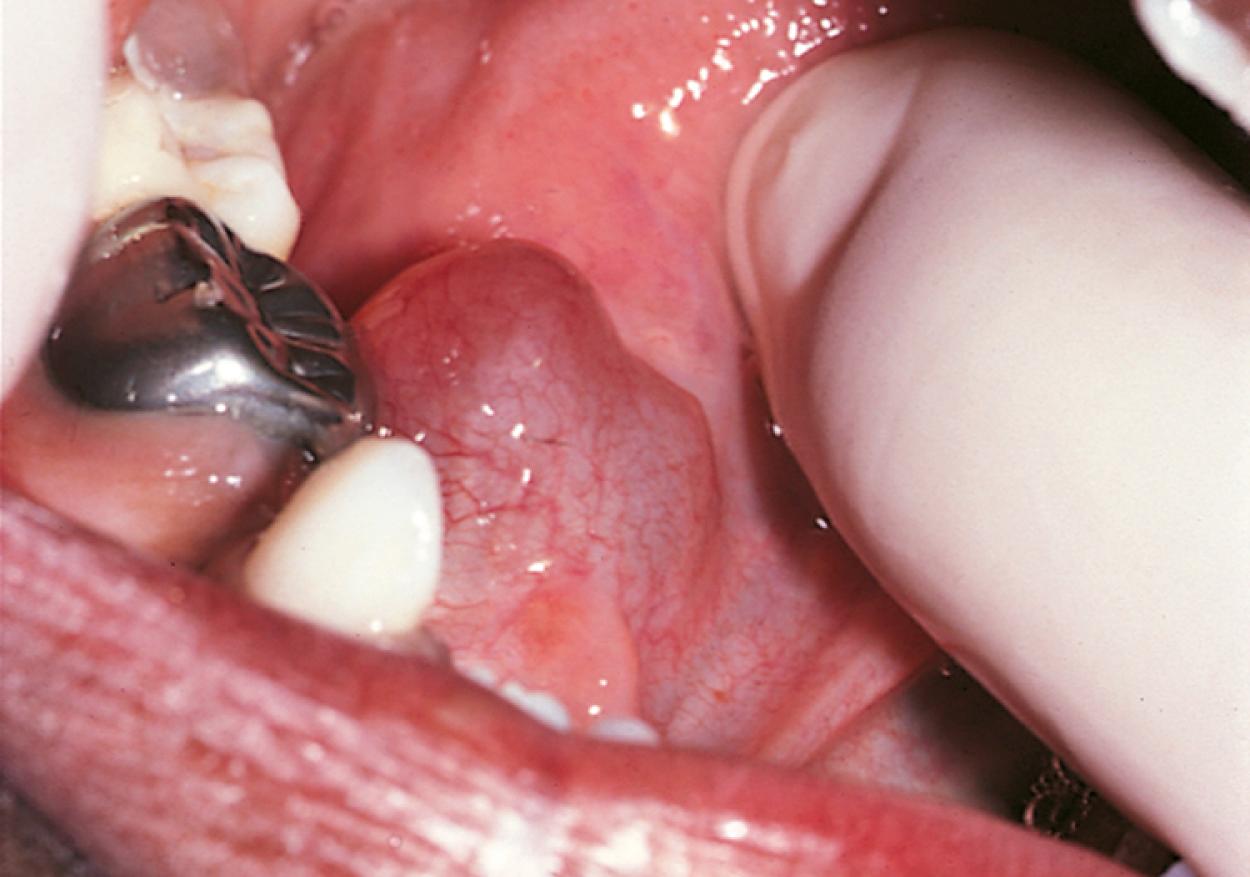
Formation of a salivary calculus is rare in the pediatric population, but when it does occur, it may affect either the Wharton duct or Stensen duct ( Fig. 21.28A ). Partial obstruction of the duct results in pain and enlargement of the gland, especially at mealtime. Although palpation of the stone may be possible, dental radiographs confirm the diagnosis and give appropriate information about its size and location (see Fig. 21.28B ). Larger salivary stones wedged within the ducts may cause localized irritation and secondary infection. If the calculus cannot be manipulated through the duct, surgical intervention may be necessary.
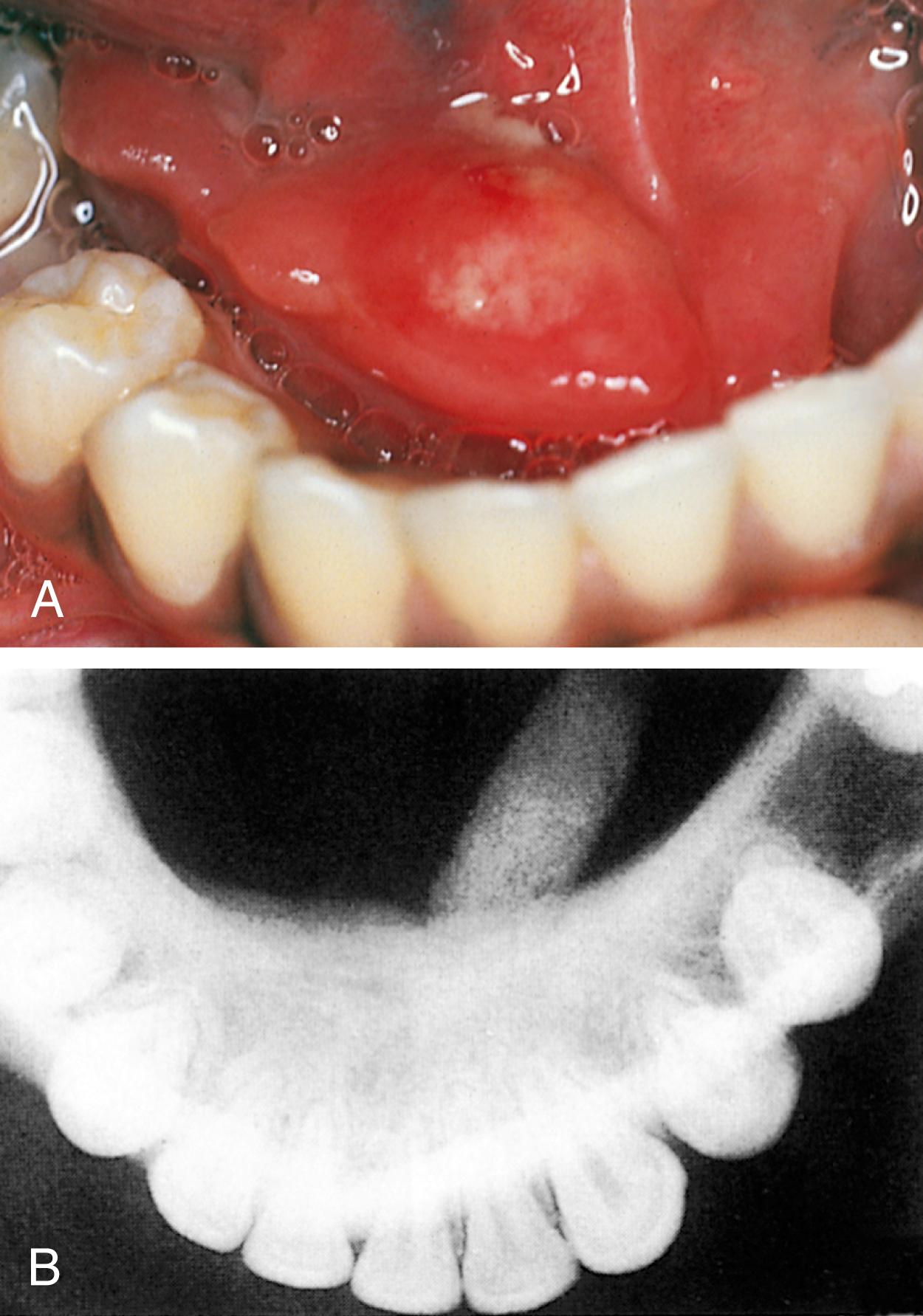
Become a Clinical Tree membership for Full access and enjoy Unlimited articles
If you are a member. Log in here